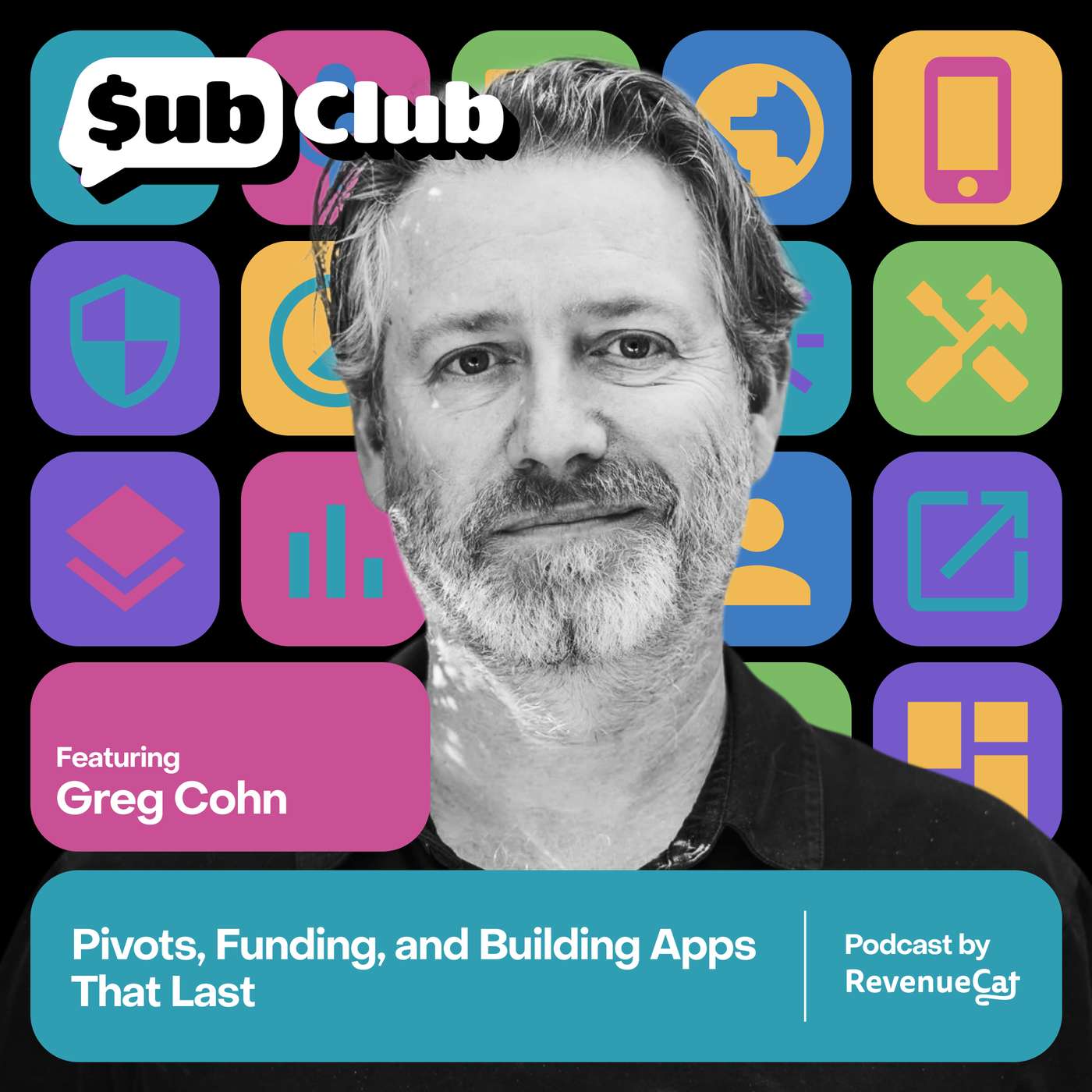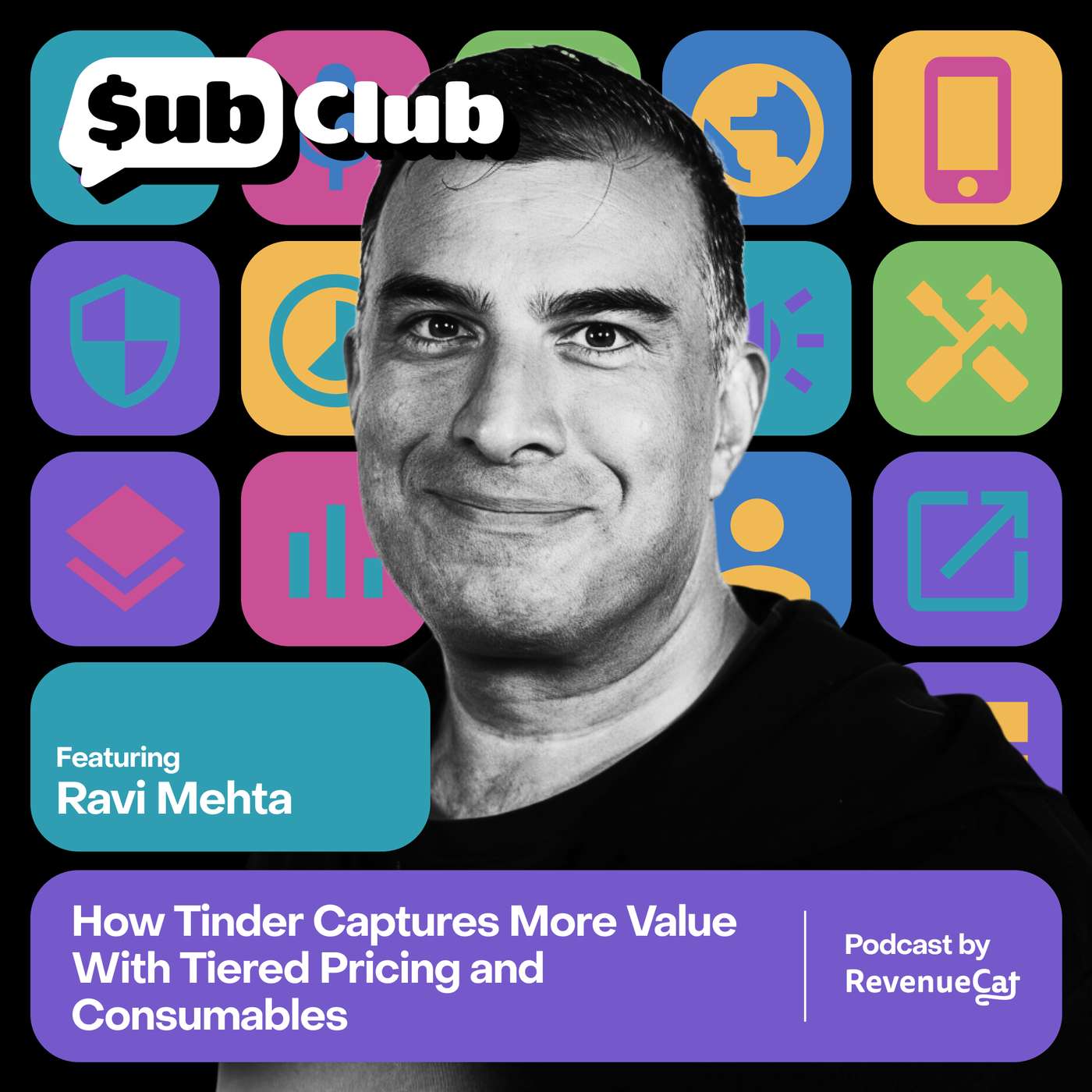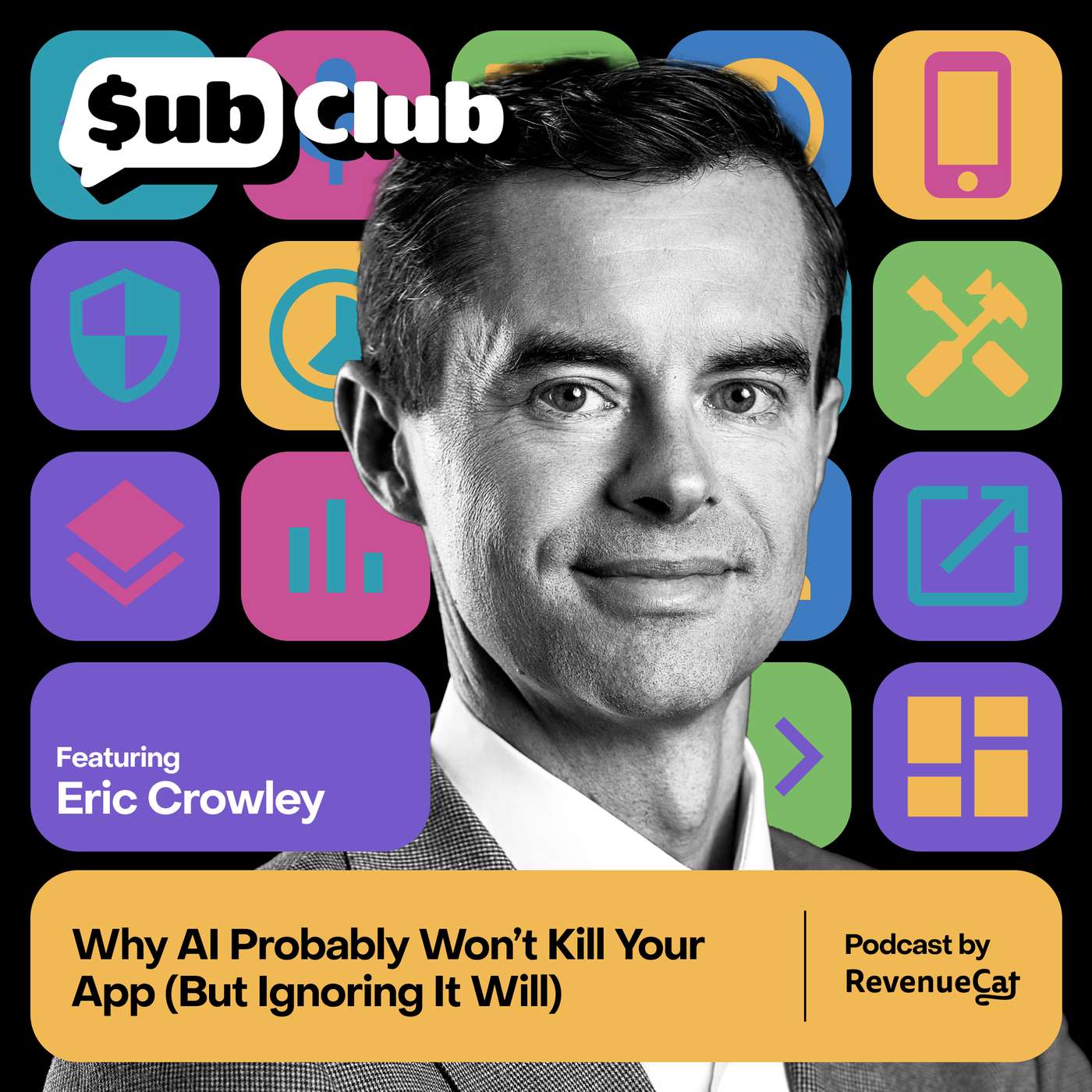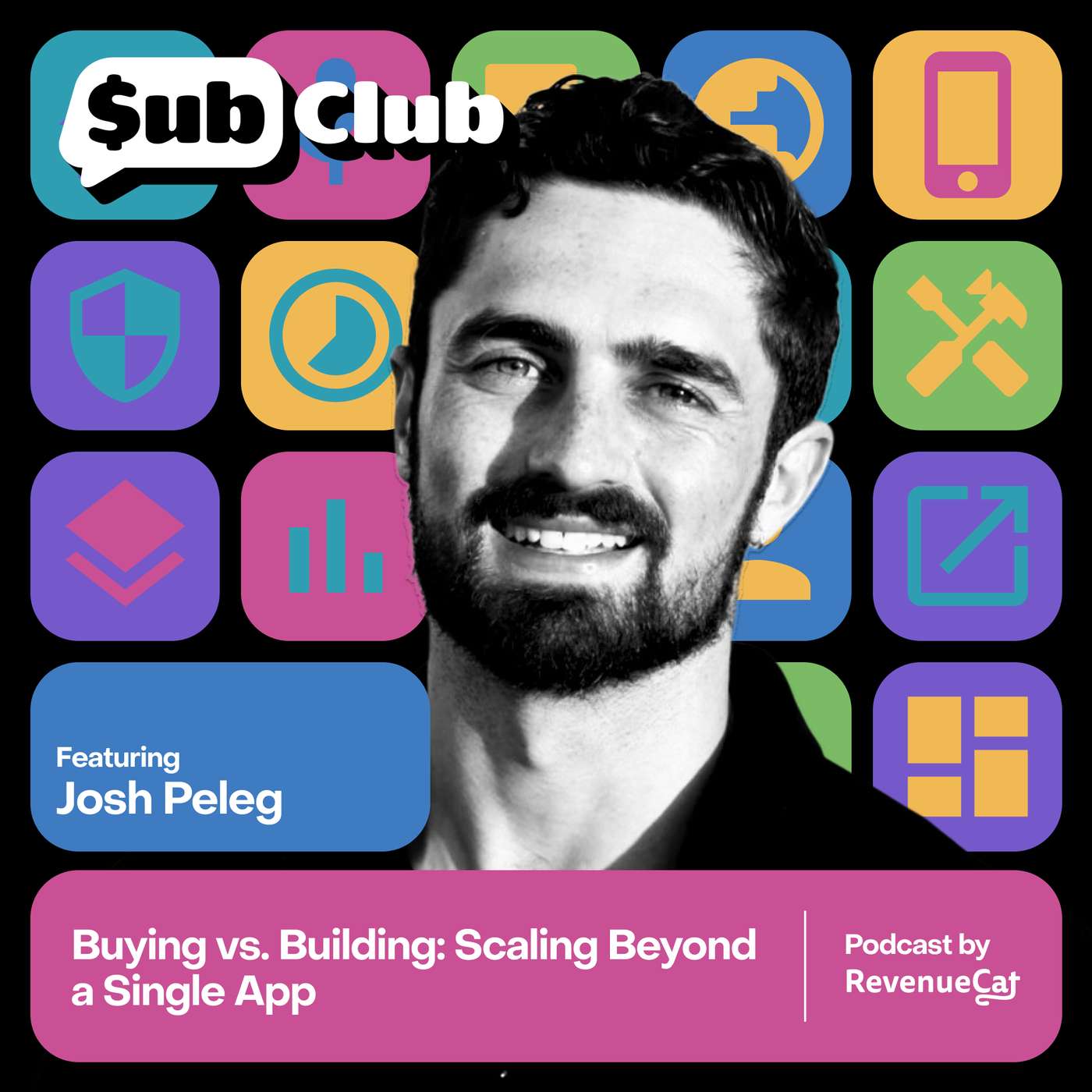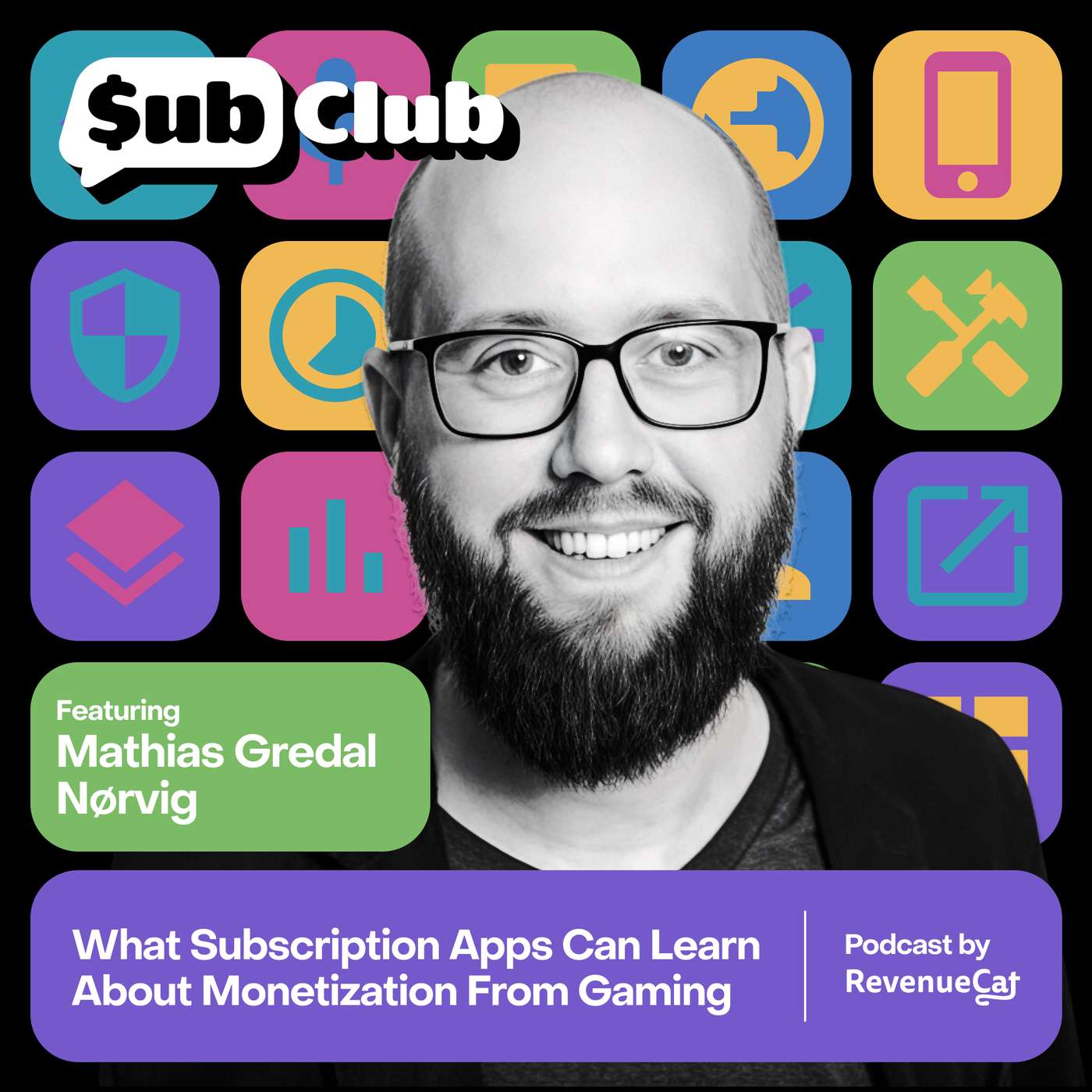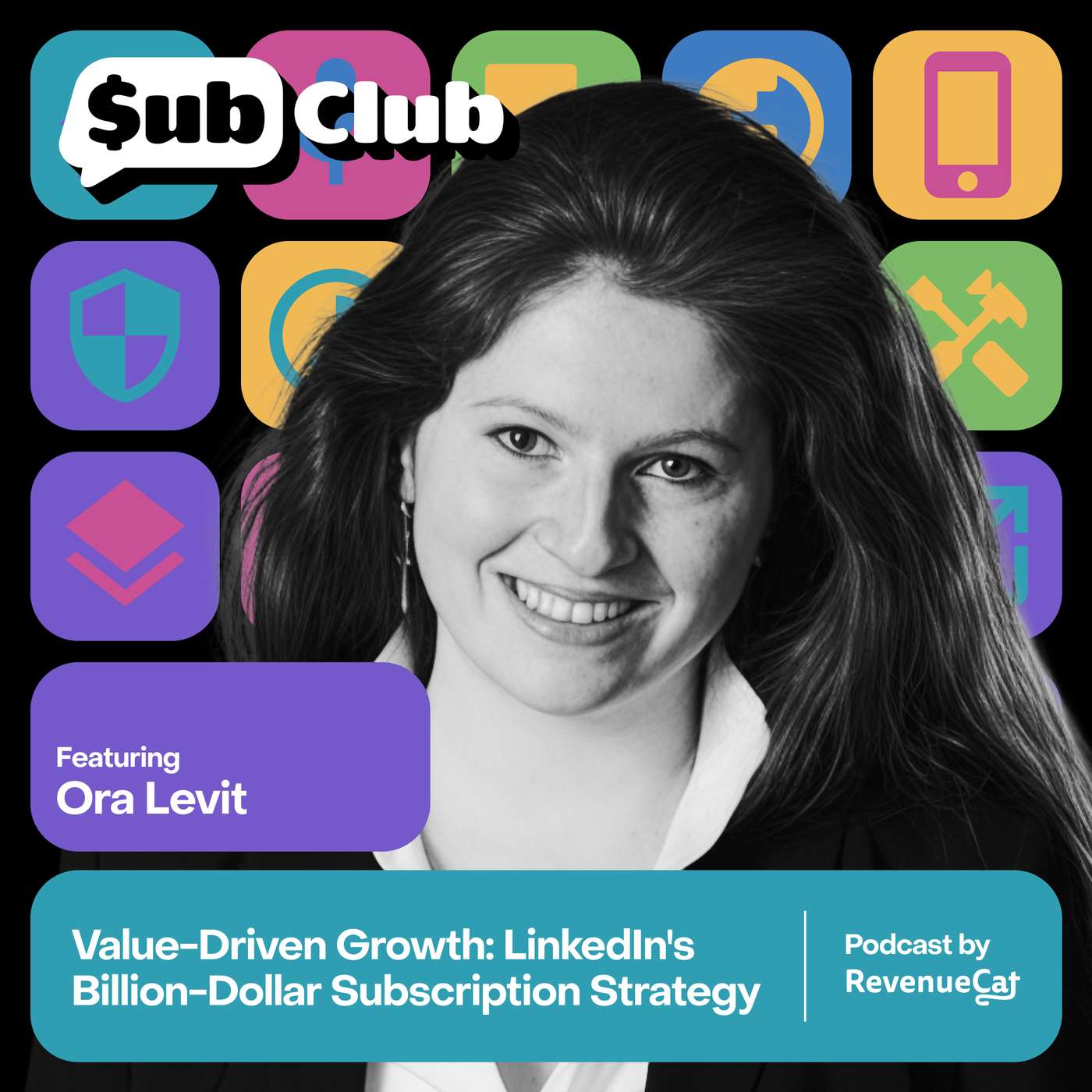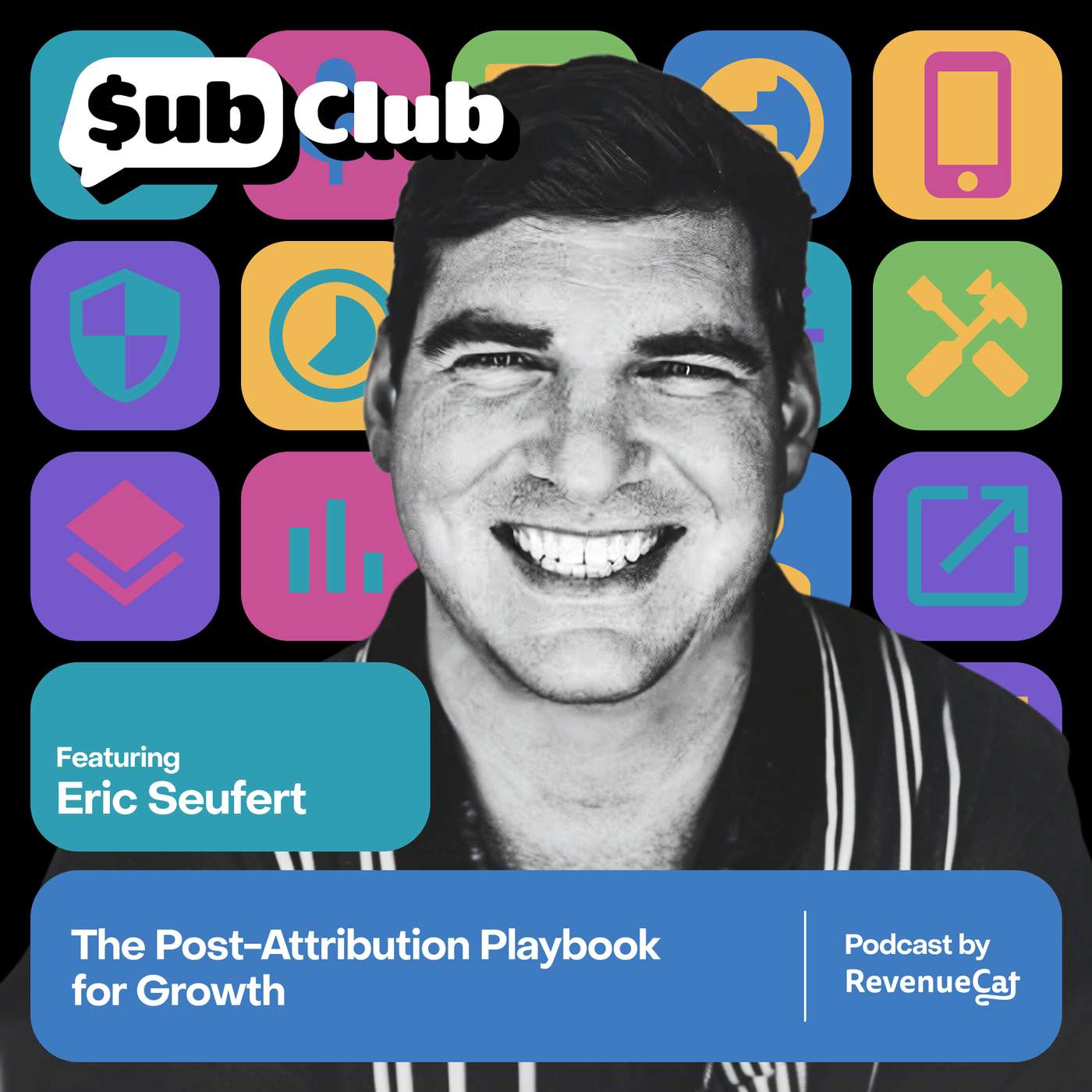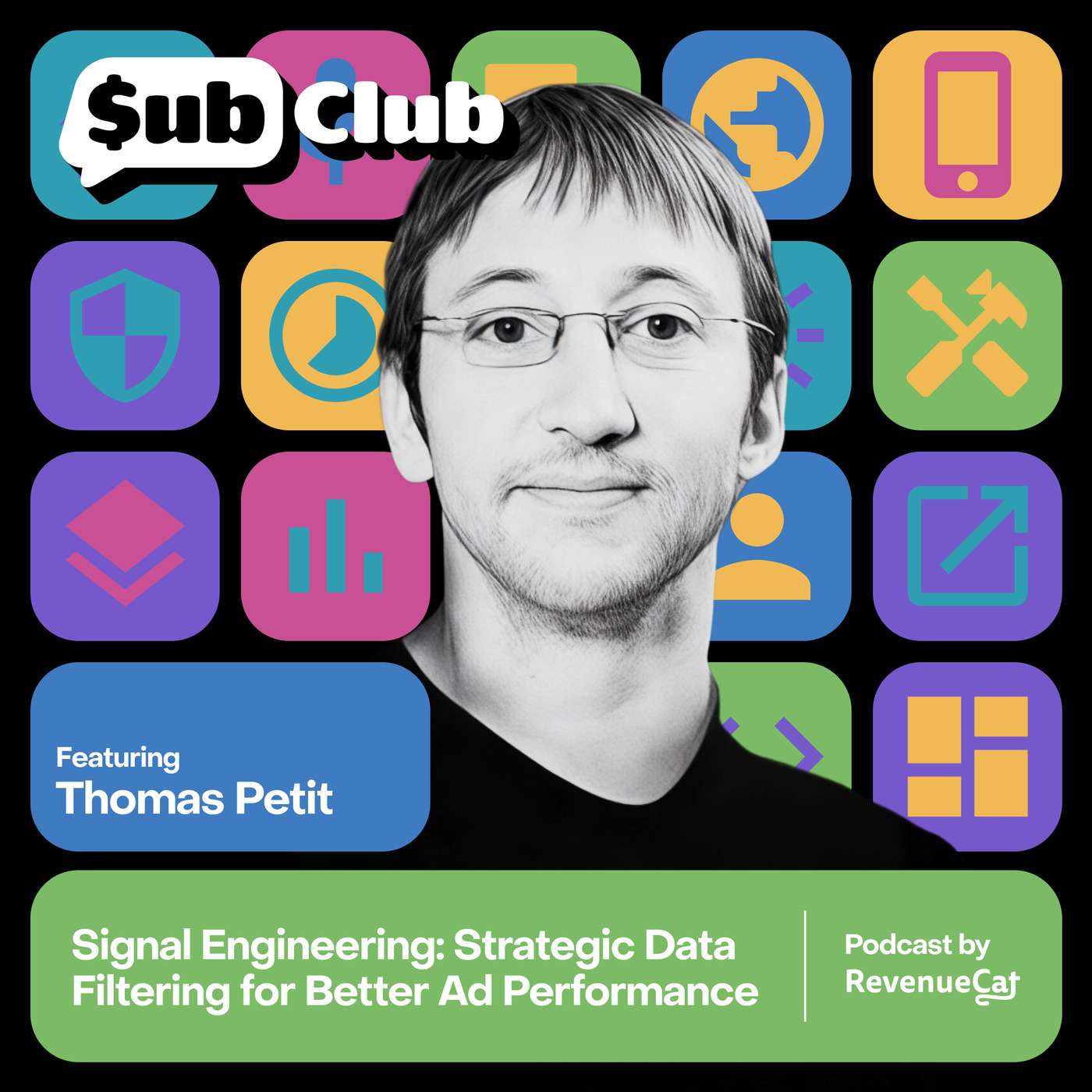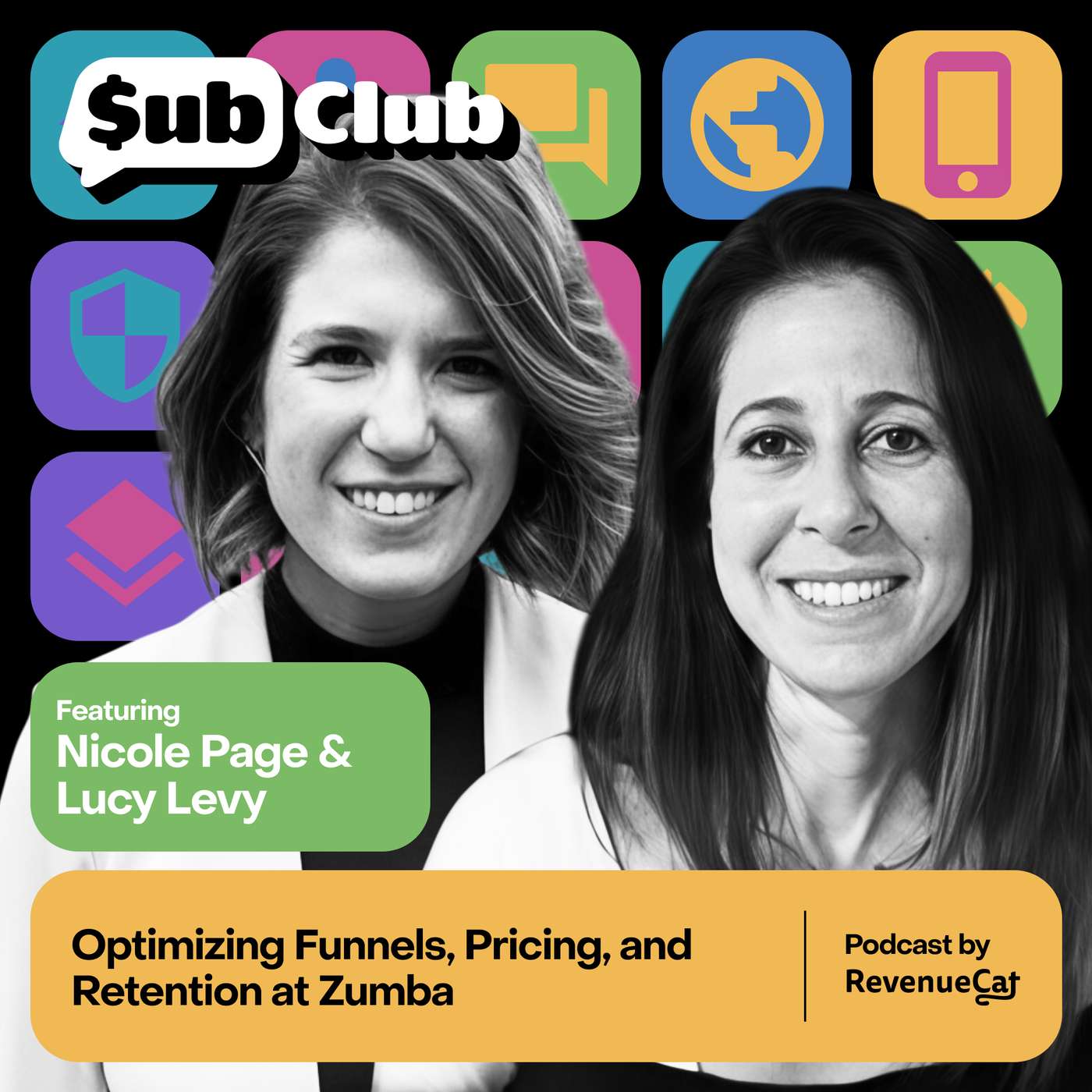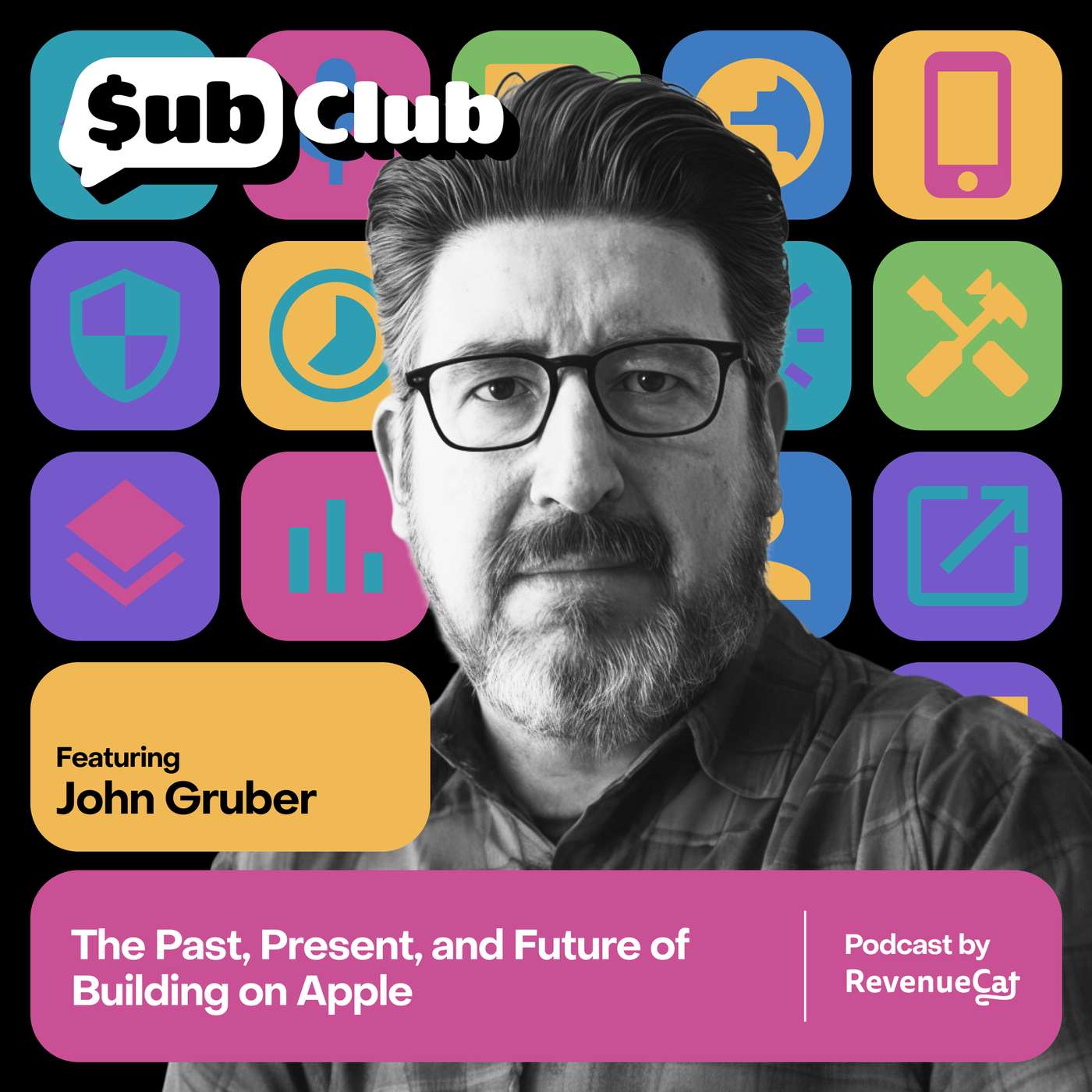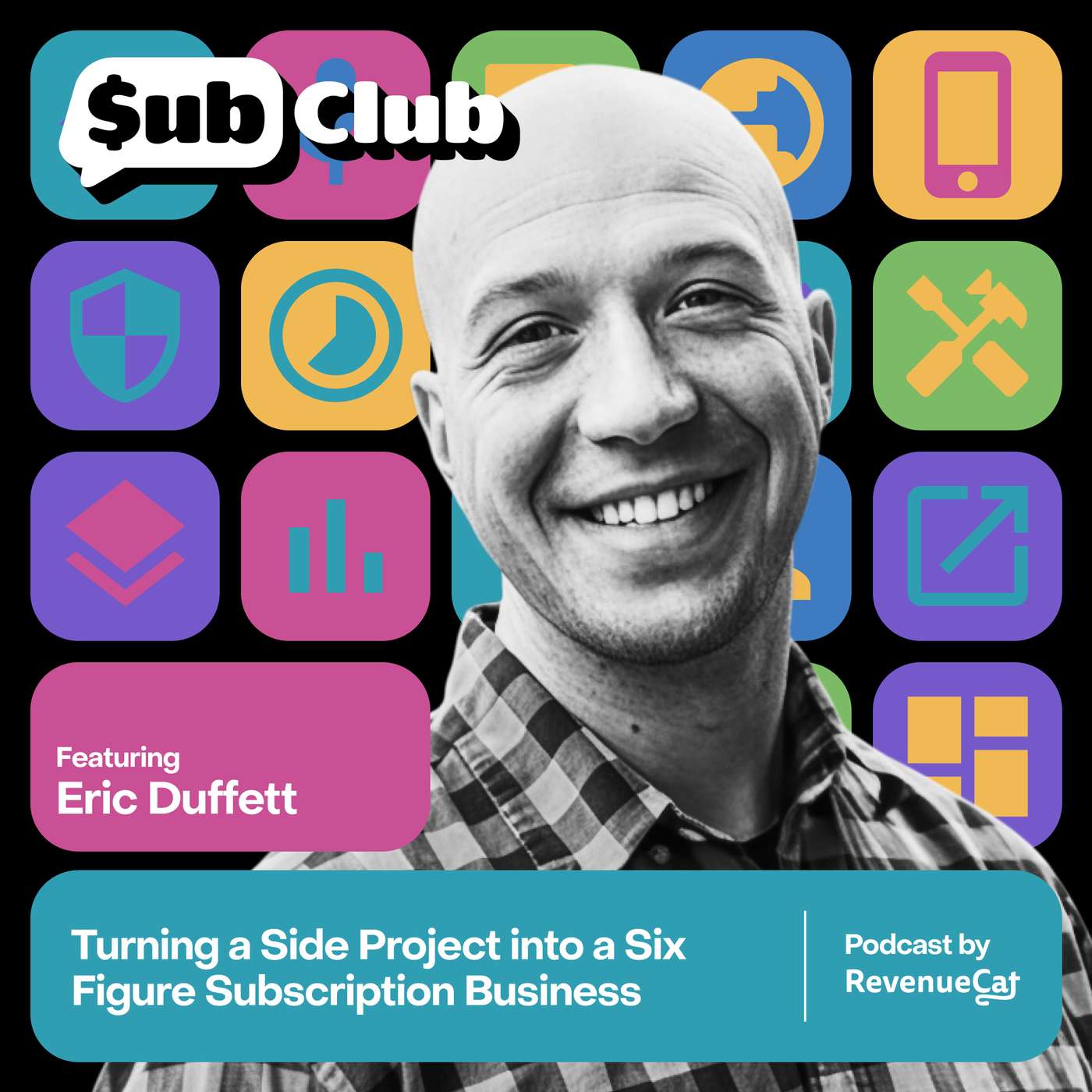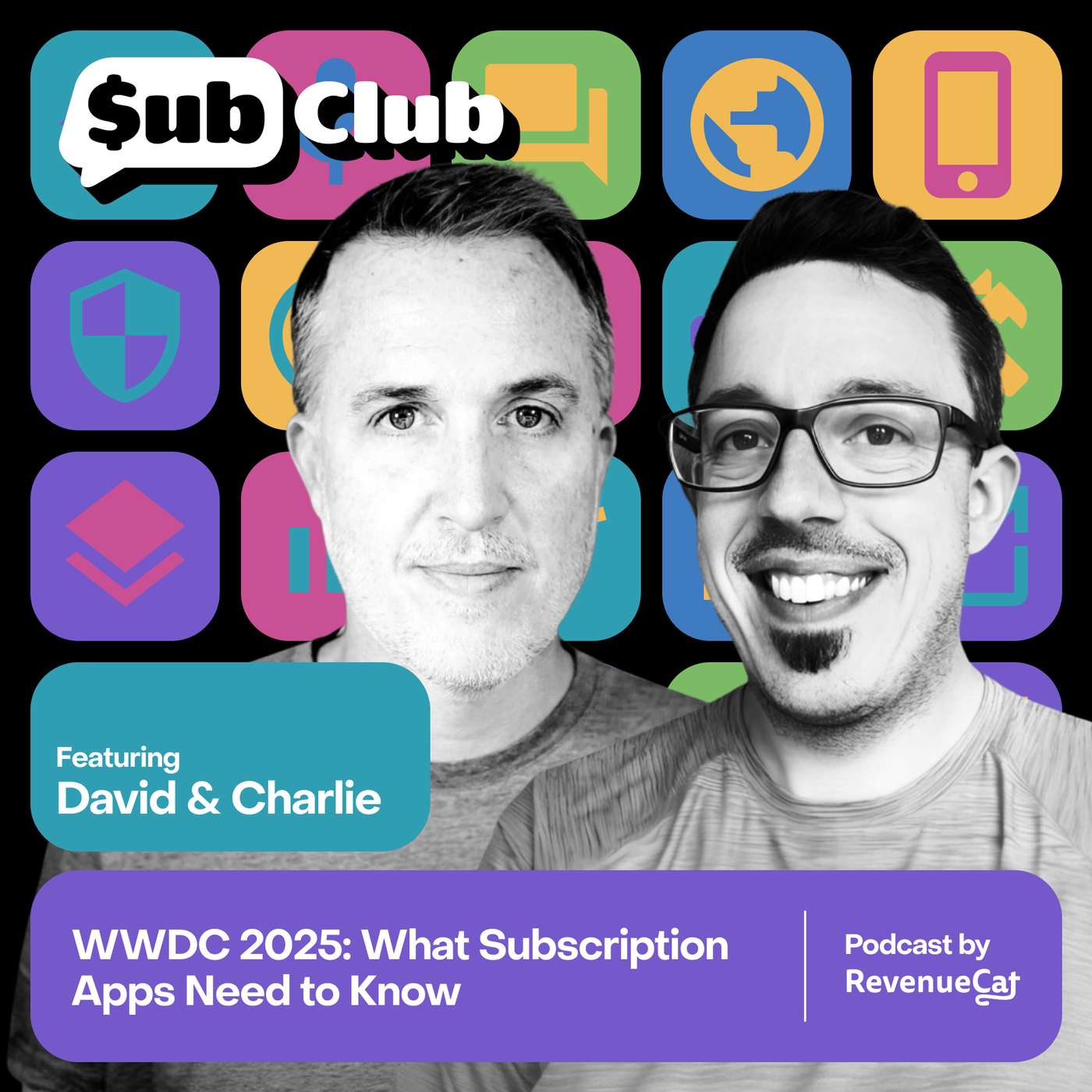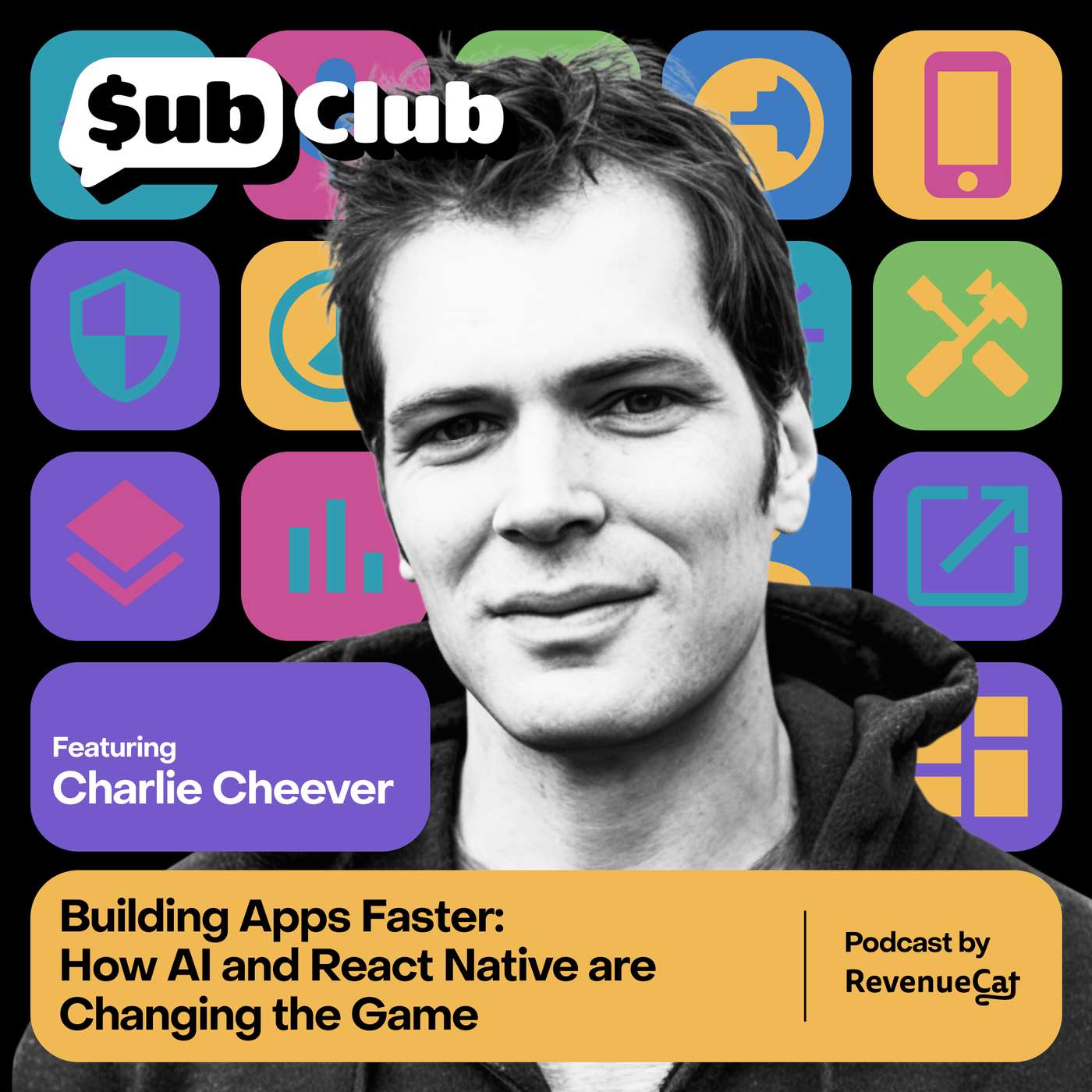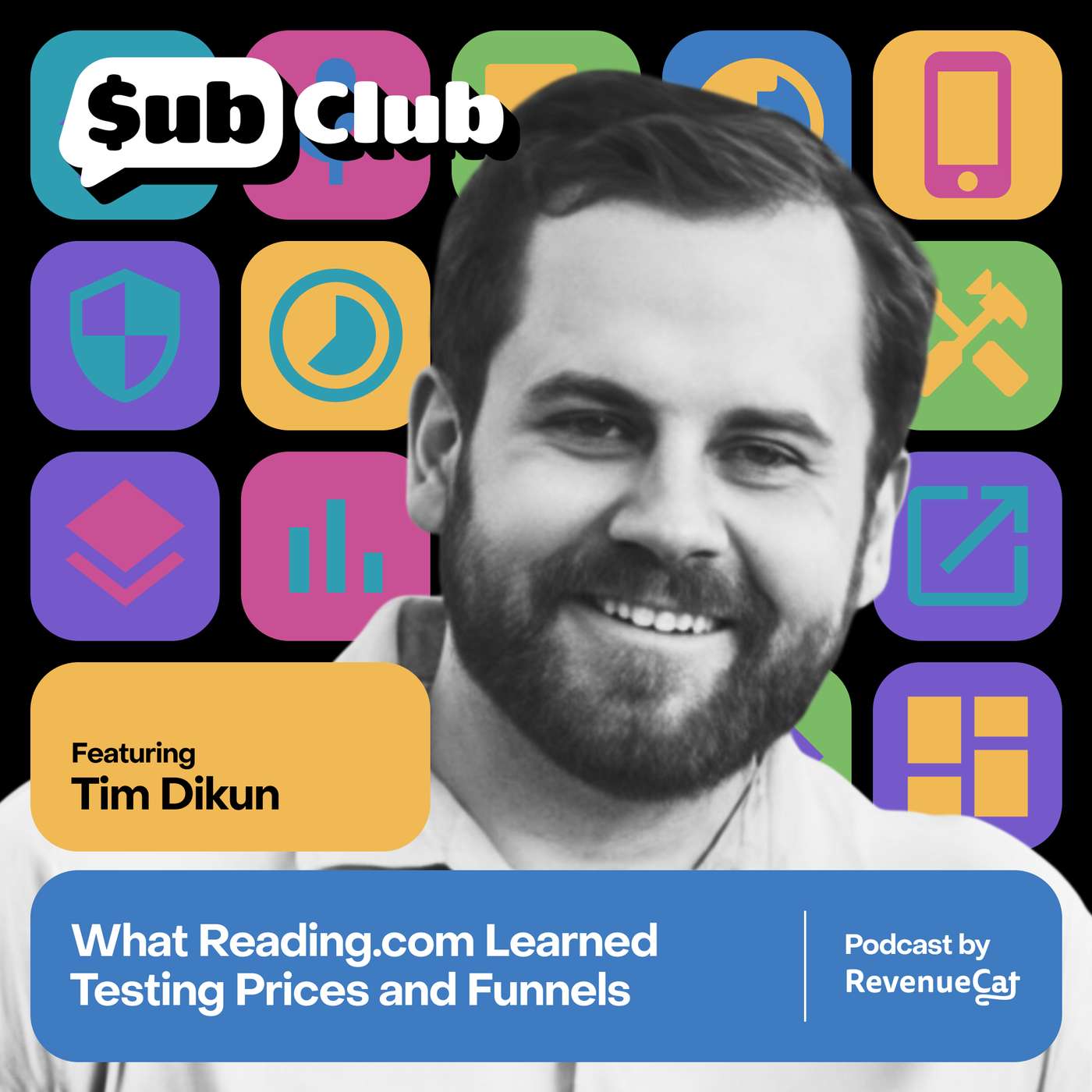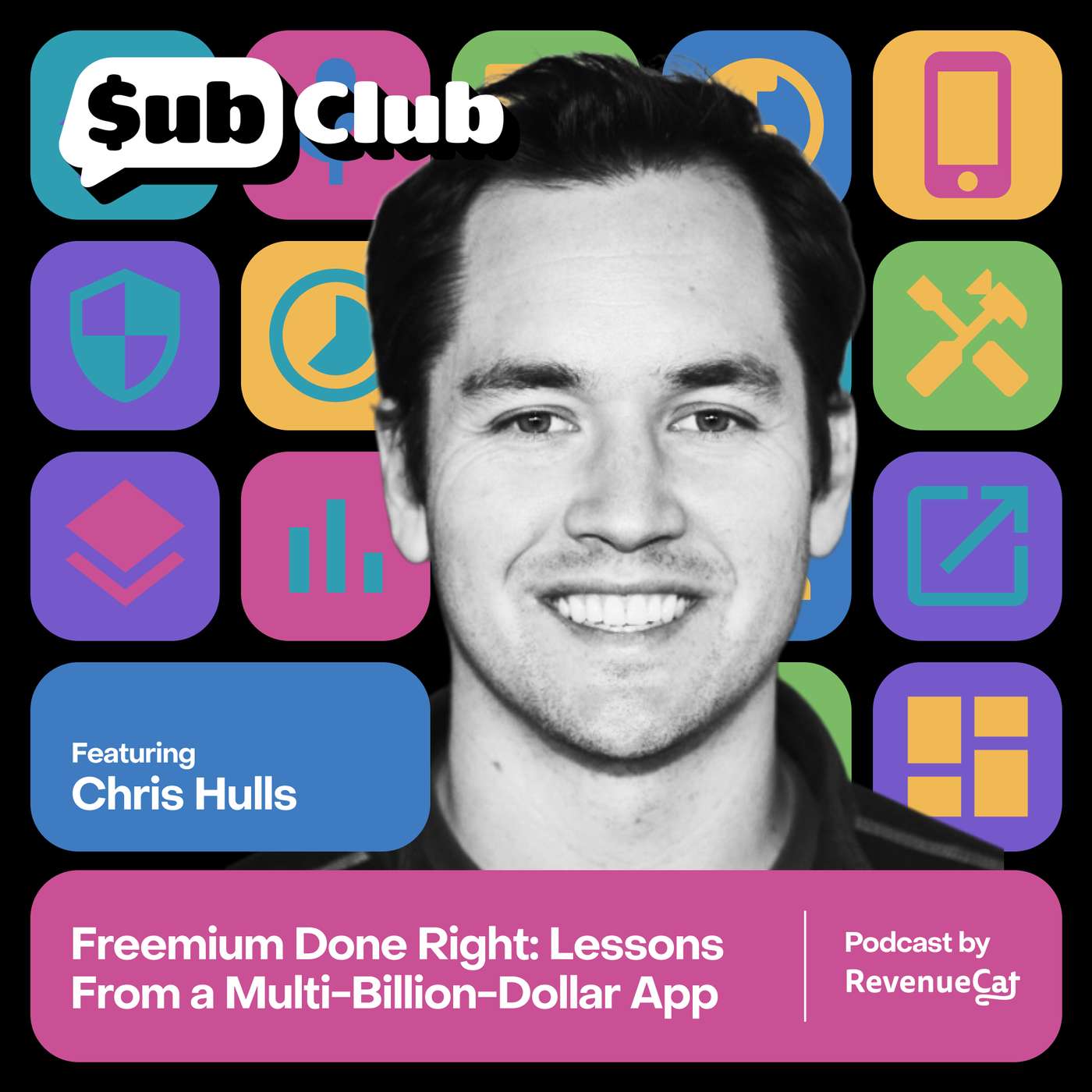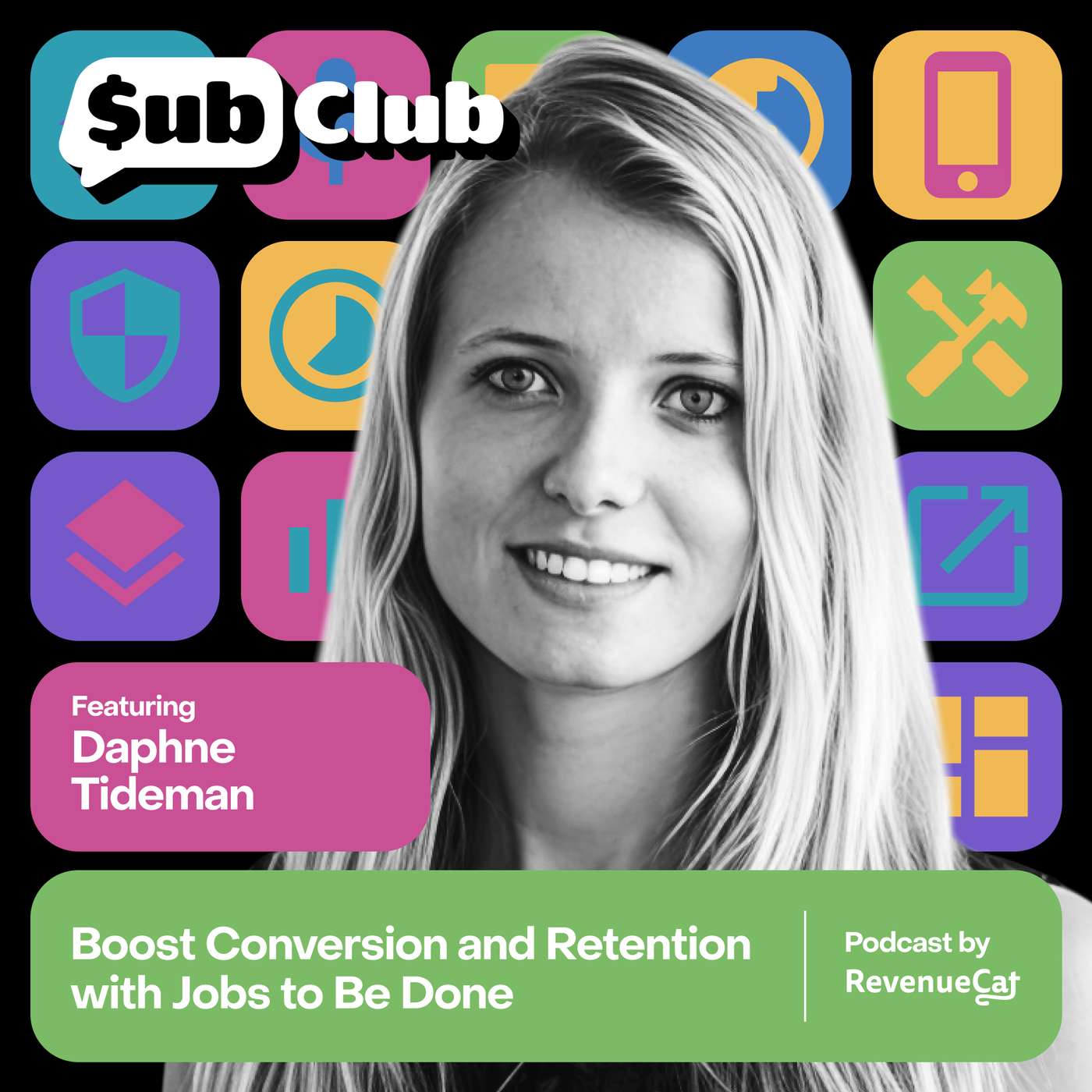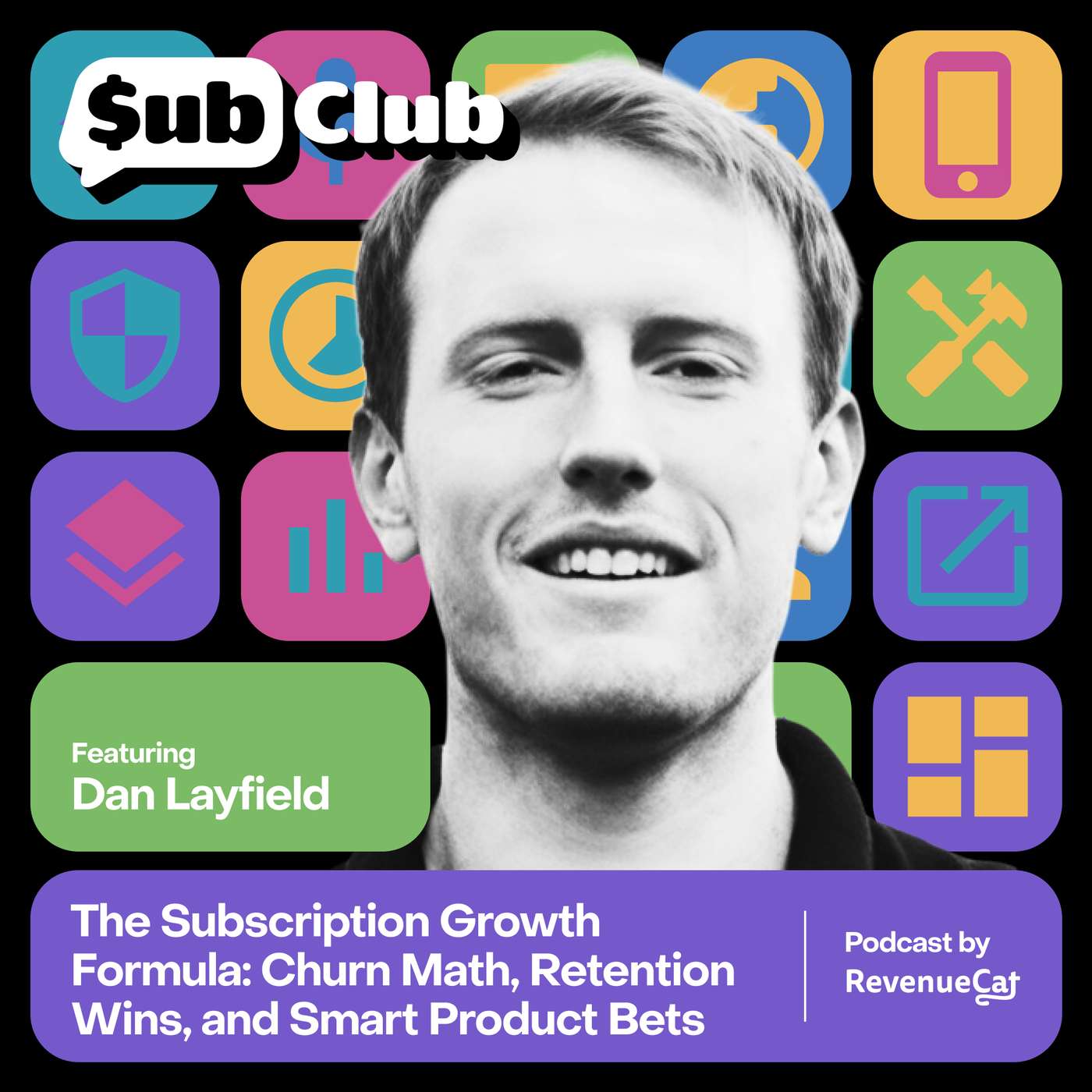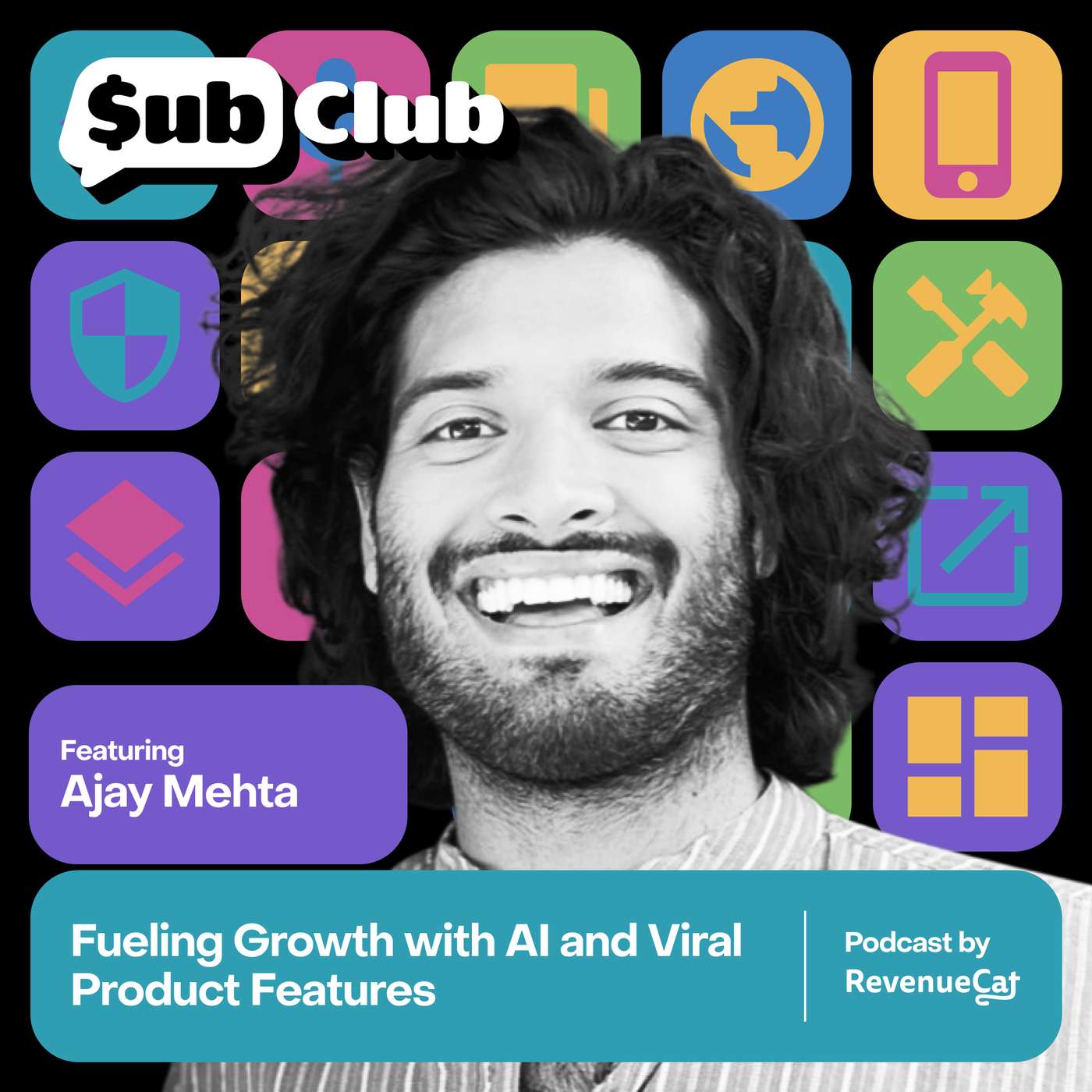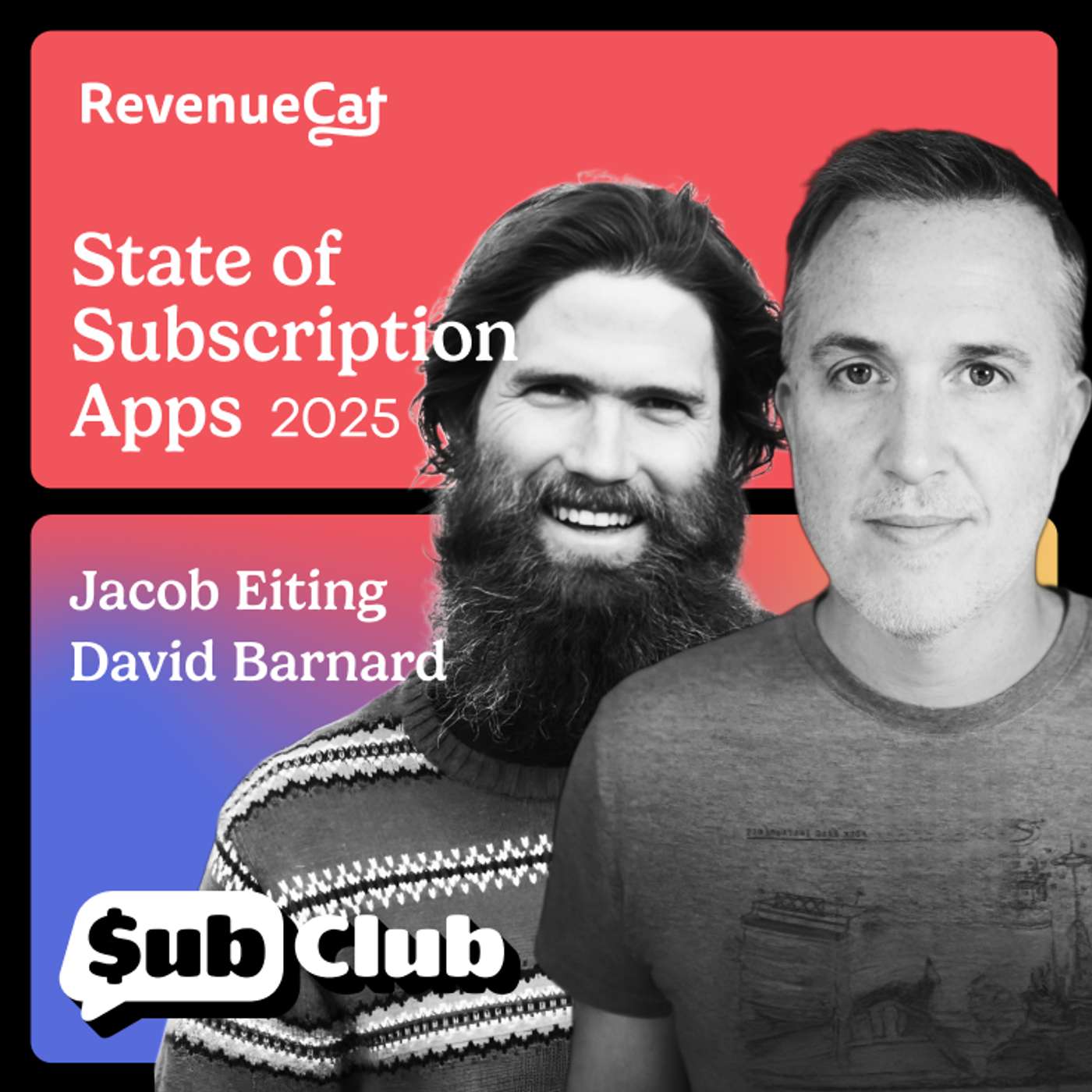Discover Sub Club by RevenueCat
Sub Club by RevenueCat

Sub Club by RevenueCat
Author: David Barnard, Jacob Eiting
Subscribed: 58Played: 1,543Subscribe
Share
© 2023 RevenueCat
Description
Interviews with the experts behind the biggest apps in the App Store. Hosts David Barnard and Jacob Eiting dive deep to unlock insights, strategies, and stories that you can use to carve out your slice of the 'trillion-dollar App Store opportunity'.
143 Episodes
Reverse
On the podcast, I talk with Greg about knowing when to pivot, why most consumer apps shouldn't raise VC, and why making free trials optional outperformed making them the default.Top Takeaways: 📉 Know When to Pivot Wrangle struggled because it wasn’t solving a real problem. Burner succeeded because it met a clear need. Don’t be afraid to pivot when the product isn’t working.💭Most Consumer Apps Don’t Need VCVenture capital can be a blessing but also a curse. If you attract investment that doesn’t line up with your product vision or culture, the cash injection can turn out to be a costly mistake. Building a business that pays for itself is a better fit for most founders. 🔑 Focus on Retention Success is about keeping users, not just acquiring them. Burner’s ability to retain users, even short-term ones, proved its value. If users keep coming back, you’ve found something meaningful.🛠 Trials, Errors, WinsTesting was crucial to Burner’s growth. Every experiment was a learning opportunity. Don’t guess—test continuously, especially pricing, to find what drives retention and revenue.🎯 Small Changes, Big Results Minor tweaks, like switching to a free trial, led to significant growth. Optimize for retention with quick, simple changes. Even minor adjustments can have a substantial impact on results.About Greg Cohn: 🛫 Founder and CEO of Ad Hoc Labs📱 Greg Cohn is the founder of Burner, the leading mobile app for managing personal privacy through disposable phone numbers. With a passion for solving real-world problems, Greg transitioned from an early startup failure to building a successful business that prioritizes user privacy, simplicity, and seamless functionality.👋 LinkedIn 💬 Text Greg’s Burner: (323) 579-1830🧑💻 Open Roles at Ad Hoc Labs (Mention “Sub Club” to get a closer look at your resume.)Follow us on X: David Barnard - @drbarnardJacob Eiting - @jeitingRevenueCat - @RevenueCatSubClub - @SubClubHQEpisode Highlights:[0:00] The concept behind Wrangle, Greg’s first app[1:39] Twilio’s role in developing Wrangle and early challenges[3:24] Burner’s breakthrough with the “burner” feature for privacy[9:42] Wrangle’s pivot and what went wrong[13:36] Moving from paid downloads to a subscription model for Burner[24:47] Importance of user feedback in shaping the Burner product[33:24] The credit system and why it transitioned to subscriptions[38:55] Why retention and cohort analysis are key to Burner’s success[44:29] How Burner integrates new features like VPN for growth[54:33] Premium tier features: phone number lookup becomes popular[1:02:18] Bundling products: the decision to expand Burner’s offerings[1:09:53] Greg’s thoughts on acquiring apps vs building new features[1:23:38] Win of the year: faster paywall testing speed for Burner
On the podcast we talk with Ravi about subscriptions as a force multiplier for consumables, why narratives matter more than metrics in goal-setting, and why you might want to try a longer onboarding, or a shorter one.📊 Stack the demand curveTinder didn’t just offer one price—it built a staircase of value. Low-tier subs, premium upgrades, and microtransactions filled in the gaps of user willingness to pay. The result? More people paid something, and some paid a lot. Don’t pick one price point. Map the whole curve. 🎯 Create value before monetizationThe fastest way to expand your TAM? Get users to the “aha” moment faster. Tinder made onboarding nearly instant to tap into a new, younger audience. In contrast, Sesame Care increased conversions with a 25-step flow by increasing user confidence. Friction isn’t the enemy—poor timing is.💰 Free is a monetization strategyAt Tinder, 85–90% of users never paid. But their presence was the product—fueling demand and justifying spend for the other 10–15%. Don’t underestimate free users. Sometimes, they’re the reason someone else is willing to pay.🧪 Price is productTinder didn’t guess what users would pay. It ran hundreds of localized price tests across SKUs to learn what users valued. Pricing isn’t a spreadsheet exercise—it’s part of the product experience and should be tested like one.📐 Narrative beats metricsOKRs fail when they skip the why. Ravi’s NCTs framework, which stands for Narratives, Commitments, Tasks, anchors goals in story and context. If your team is hitting the numbers but drifting on focus, it’s probably time to start with the story—not the spreadsheet.🪞 Monetization reveals product market fitMost apps undercharge. A scanner app might seem basic, but if it powers daily workflows, it’s worth real money. Set your price high enough to test willingness, not just conversion. If no one bites, you don’t have a monetization problem—you have a product one.About Ravi Mehta: 🔥 Former Chief Product Officer at Tinder and product leader at Meta, TripAdvisor, and Microsoft.📈 Ravi helps companies turn behavioral insights into scalable monetization systems — from multi-tier subscriptions to habit-forming onboarding flows.🗣 “If you have a product that’s solving an important need for someone, there’s a system around that that fits into the problem you’re solving, and you should think about the value of that system rather than just the price.”👋 LinkedInFollow us on X: David Barnard - @drbarnardJacob Eiting - @jeitingRevenueCat - @RevenueCatSubClub - @SubClubHQEpisode Highlights: [0:00] Subscriptions as a force multiplier for consumables[3:03] Filling the demand curve with tiers and microtransactions[6:47] Why free-to-play was Tinder’s breakthrough innovation[10:26] Matching monetization to different user behaviors[13:09] Creating value for whales without breaking the game[17:22] Experimenting your way into the perfect pricing model[20:03] When free, trial, or paid onboarding makes the most sense[23:47] Why apps are undermonetized and how to fix it[28:43] Why a longer onboarding boosted conversion 40%[35:20] How shorter onboarding expanded Tinder’s total market[43:03] Narratives, commitments, and tasks: a better goal framework[01:02:49] Growth is easier when you own your audience
On the podcast, we talk with Eric about the opportunities and challenges of AI for consumer apps, what you can learn from Strava acquiring Runna, and the flawed thinking around ‘subscription fatigue’.Top Takeaways:💸 Value Overcomes FatigueConsumers would rather not pay for anything, but when a product delivers real value, they are happy to pay, even via subscriptions. Whether it’s training for a race, protecting memories, or learning something new, utility drives retention. Building long-term value wins every time.🧠 Build a ‘Category Killer’Eric identified ‘Strava for Pets’ and ‘Managing screen time and digital focus’ are opportunities for future ‘category killer’ apps. What do those two opportunities have in common? They are in categories where people are already spending a lot of money or have the opportunity to save a lot of time or money.🤝 Build to be loved, not acquiredThe best M&A strategy? Build something consumers truly love. Runna didn’t sell to Strava because they planned for it, building cool features Strava didn’t have. They sold because Runna was a fantastic product that personalized running in a way that expanded the market Strava couldn’t. ⚙️ Growth requires tough choicesConglomerates like Bending Spoons win through ruthless efficiency. They acquire apps, cut costs, and apply repeatable growth playbooks at scale. It can be controversial, but sometimes it takes an outsider to spot that the team that took an app to 1,000 users may not be the team to take it to 100,000 and beyond.📈 AI changes discoverySearch behavior is shifting, and SEO is no longer the only path to discovery. AI tools are becoming the starting point for many journeys, forcing marketers to rethink how users find and engage with products. Adapting to this shift means reimagining acquisition, not just tacking on AI features.About Eric Crowley: 👨💼 Partner at GP Bullhound, a global investment bank and venture capital firm.💰 Eric leads the Consumer Subscription Software (CSS) practice, advising high-growth companies on capital raises and acquisitions—recently including AllTrails and Runna.📊 “If you build a product that consumers truly love, strategics will come calling. It’s that emotional connection that drives outsized outcomes.”👋 LinkedInFollow us on X: David Barnard - @drbarnardJacob Eiting - @jeitingRevenueCat - @RevenueCatSubClub - @SubClubHQEpisode Highlights: [0:00] Opportunities in subscription apps[7:12] Consumers still pay when the product delivers lasting value[10:41] What Strava’s acquisition of Runna reveals about building apps that get bought[17:30] Genuine consumer love over designing for a single acquirer[19:27] Shifts in discovery forcing app marketers to rethink SEO and acquisition[28:56] Using AI to move faster, create better products, and deepen moats[32:47] How loosened restrictions could return profit margins for top apps[46:43] The next big subscription plays[52:04] Why Bending Spoons are forcing investors to rethink consumer tech[57:11] What makes the Bending Spoons model work[1:00:10] The Secondary market is changing how founders think about app exits[1:01:41] Trends, exits, and the state of the subscription app ecosystem
On the podcast, I talk with Michael about the blessing and curse of having a brand, why post-purchase is the perfect upsell moment, and why partnerships are hard to pull off but can be well worth the effort.Top Takeaways:🌱Growth is Built on ValueSustainable growth comes from consistently adding value, not just short-term tactics. Success lies in constantly evolving your product to meet users' needs. By regularly introducing new features and improving the user experience, premium products remain relevant and compelling. That value is continuous, with acquisition and retention working together to drive long-term growth.🎯 Personalize for Retention Different users have different goals, and understanding this is key to retention. Tailor offerings to specific user needs, whether it is job seekers, hobbyists, or niche audiences. By tailoring plans and features to user intent, brands can keep their products relevant. Without this personalization, users may disengage and churn.📊 Test to OptimizeWith hundreds of A/B tests each year, Condé Nast learns what works quickly. Data replaces debate, helping the team iterate faster. The goal is not just to optimize, it is to foster a culture of constant learning and growth.🔄 Retention Is a Journey Churn does not always mean goodbye. Many users return later when their needs change. Offering win-back deals, fresh trials, and adding new value helps bring users back and turn them into long-term subscribers. Retention is a process, not a straight line.🤖 AI Supports, Not LeadsAI should enhance the user experience, not overshadow it. AI’s role is to solve problems, helping users find content or personalize their experience, while staying behind the scenes. The real value is in solving the user’s needs, not in the technology itself.About Michael Ribero: 👨💻 SVP, Global Consumer Revenue at Condé Nast.📈 Michael leads the subscription and growth strategies for some of the world’s most iconic media brands, including Vogue, GQ, The New Yorker, and Wired. He focuses on optimizing user engagement, experimenting with monetization strategies, and evolving the digital experiences that drive both free and paid subscriptions.💡 "We’ve learned that true growth comes from continually adding value. Our approach isn’t just about scaling; it’s about providing lasting benefits that evolve with our users’ needs."👋 LinkedInFollow us on X: David Barnard - @drbarnardJacob Eiting - @jeitingRevenueCat - @RevenueCatSubClub - @SubClubHQEpisode Highlights: [0:00] Why launching a premium tier isn’t always the right move[2:51] Competing with AI-native upstarts and influencer content[5:39] Media's frenemy dynamic with platforms like Meta[8:25] Balancing free vs. paid content without eroding brand trust[11:46] How to recover from a failed paywall experiment[13:23] What bundling and post-purchase upsells look like at Condé Nast[19:41] Real-world LTV boosts from zero-CAC upsell moments[22:30] Lessons from low-priced tiers like the Washington Post’s Starter Pack[26:07] Tiering vs. focus: when a premium plan is actually a distraction
On the podcast I talk with Josh about red flags that tank app valuations, why subscription-only apps are leaving money on the table, and how bootstrapped founders are cashing out for millions in months, not years.Top Takeaways:🎯 Build to sell, but build smartFlipping an app in under a year is still possible, but the skill that matters most now is marketing. With AI lowering the barrier to development, distribution has become the real differentiator. Founders who master organic channels, community, and creator-driven marketing are the ones who land meaningful exits.💰 Predictability drives valueBuyers pay more for revenue they can trust. Apps built on recurring subscriptions with strong retention and low churn are far more attractive than those relying on ads or one-time purchases. Predictable cash flow isn’t just safer, it’s worth a higher multiple.🚩 Short-term tricks destroy long-term valueArtificially inflating numbers before a sale, such as pushing lifetime deals to boost revenue, can quickly kill a deal. Serious acquirers look for sustainable metrics, not spikes. Authentic growth, honest reporting, and healthy retention are the hallmarks of a business built to last.🔄 Fewer and deeper betsThe age-old quality-over-quantity principle still holds. After buying nearly a hundred small apps early on, BlueThrone learned that broad portfolios don’t win. Their new playbook focuses on a handful of apps with real product-market fit, strong organic traction, and teams ready to scale into category leaders.💡 Hybrid monetization unlocks new growthBorrowing tactics from gaming, like consumables, day passes, and rewarded ads, helps subscription apps reach more users and capture more value. These models make spending feel flexible and fair, turning a single price point into an entire revenue spectrum.About Josh Peleg: 📈 Head of Business Development and M&A at BlueThrone, one of the world’s leading app acquirers.💡 Josh helps founders scale and exit their apps, guiding deals that range from six to eight figures.🎮 Before joining BlueThrone, he led mergers and acquisitions in the mobile gaming industry, giving him a front-row view of how distribution and monetization strategies evolve.🗣 “The best apps today aren’t just great products—they’re great stories. Marketing and distribution are what turn a good idea into a real business.”👋 LinkedInFollow us on X: David Barnard - @drbarnardJacob Eiting - @jeitingRevenueCat - @RevenueCatSubClub - @SubClubHQEpisode Highlights: [0:00] Lesson learned from BlueThrone’s early “go-wide” strategy [6:20] Why founders have to be more than great builders [8:19] The pieces that lead to higher valuations[12:37] Five signals that can kill a deal[18:12] When (and when not) to raise[24:33] Shifting from a broad portfolio to a few deep bets [33:15] The future of monetization[45:07] What drives the best exits in today’s acquisition market[52:00] How founders can position themselves for life-changing exits
On the podcast we talk with Mathias about running Subway Surfers' marketing machine on salaries, not ad spend, leaving money on the table to protect player experience, and why more apps should try rewarded ads, season passes, and other tactics from gaming.Top Takeaways:🎨 Viral flywheels can out-perform massive paid campaignsRelying on salaries instead of ad budgets, a lean team can ship constant creative that rides cultural waves. Most experiments flop quietly, but the occasional viral hit fuels downloads across platforms and even influences app store featuring. The lesson: volume, autonomy, and cultural fluency can rival—or surpass—big-spend marketing.🛡️ Protecting user experience is a growth strategyIt’s tempting to squeeze harder on monetization, but avoiding overly aggressive tactics can pay off longer-term. By keeping the core product endlessly playable and resisting short-term optimization, teams can build evergreen engagement that compounds for over a decade. Sometimes the best ROI comes from not chasing every last dollar.🎁 Rewarded ads expand who you can monetizeGiving users the choice to watch ads in exchange for perks isn’t just a gaming trick—it’s a fairness mechanism. It allows players in tier-two and tier-three markets, who may never subscribe, to still contribute value. Apps beyond gaming can borrow this playbook to reach broader audiences without alienating core users.⏱️ Season passes deliver transparency and trustUnlike recurring subscriptions, passes offer clear value over a fixed time window: pay once, play (or use) for the season. This structure avoids the “forgotten subscription” resentment while still generating meaningful revenue. It’s a model that translates well to utilities and lifestyle apps where usage is bursty or seasonal.🤝 Collaborations multiply reach without heavy spendCrossovers between brands or products can reactivate lapsed users and bring in new audiences, even when no money changes hands. Like the music industry learned with features, one plus one can equal three when two strong IPs join forces. Subscription apps in adjacent niches can create the same effect.About Mathias Gredal Nørvig: 👨💻 CEO of SYBO, the company behind the smash hit mobile game Subway Surfers.📈 Mathias and the small-but-mighty SYBO content marketing team have built a freemium mobile app with serious staying power.💡“How do we entertain as many players as possible with something as available as possible, but also allow those who want to spend … money to progress or get more content to do so — without the expense of ruining the fun for the majority?”👋 LinkedIn Follow us on X: David Barnard - @drbarnardJacob Eiting - @jeitingRevenueCat - @RevenueCatSubClub - @SubClubHQEpisode Highlights: [1:01] Staying power: How a subscription app like Subway Surfers achieves longevity with over 4.5 billion downloads.[4:30] Surfing the waves: How the Subway Surfers in-house creative marketing team creates and rides virality waves.[8:50] The content flywheel: How subscription apps can become self-sustaining with organic marketing.[16:27] Cash flow: What subscription apps can learn from the mobile gaming industry about alternative monetization strategies.[19:51] Paying the piper: How to balance a good user experience with when and how to require payment.[25:30] A watchful eye: The challenges of preserving brand reputation and protecting underage users in a freemium app that serves ads.[28:48] Teaming up: Avoiding cannibalization and partnering with competitors in the free-to-play space.[41:17] Day pass: How apps can experiment with consumables, day passes, and season passes to unlock new revenue opportunities.
On the podcast we talk with Ora about LinkedIn’s value-driven growth philosophy, how they personalize experiences and plan offerings based on user intent, and the complexity of running over a thousand experiments a year.Top Takeaways:🌱 Growth follows valueThe surest path to long-term growth is adding features and benefits that genuinely help people achieve their goals. Growth tactics may bring a spike, but sustainable revenue comes from a product that keeps evolving so members find new reasons to return. When value creation is continuous, acquisition and retention become self-reinforcing.🎯 Personalize by intentNot all users are looking for the same outcome. Job seekers, small business owners, and learners need different experiences. Matching plans, features, and paywalls to their specific intent—whether expressed directly or inferred from behavior—makes the product feel relevant and worth paying for. The alternative is irrelevance, which guarantees churn.📊 Test like a scientistScaling experimentation changes the culture: debates give way to data. By running over a thousand tests a year, teams learn faster, spot what actually resonates, and avoid relying on intuition alone. The goal isn’t just to optimize pricing or layouts—it’s to build a habit of constant learning that compounds into growth.🔄 Retention isn’t linearChurn doesn’t always mean goodbye. Many users return months or years later when their needs change—“boomerang” behavior that can become a meaningful revenue stream. Win-back offers, refreshed trials, and simply continuing to add new value all help capture these returning customers and turn them into long-term loyalists.🤖 AI is a tool, not the storyArtificial intelligence should quietly power better outcomes, not become the headline. Helping users write a stronger profile, find the right lead, or save time drafting a job description creates tangible value. Positioning AI as a behind-the-scenes helper keeps the focus where it belongs: solving the user’s problem.About Ora Levit: 👨💻 Vice President of Product Management at LinkedIn.📈 Ora manages LinkedIn’s billion-dollar online subscription businesses, growing both the free weekly active user base and adding value for LinkedIn Premium subscribers.💡“Our offering changes over time, and as I mentioned, we believe in value-driven growth. We add a lot of value. And so the Premium that you've seen if you subscribed two years ago is not the Premium of today. It's a very different product, and I want you to try it out.”👋 LinkedInFollow us on X: David Barnard - @drbarnardJacob Eiting - @jeitingRevenueCat - @RevenueCatSubClub - @SubClubHQEpisode Highlights:[0:00] Value add: How LinkedIn centers value-driven growth in their product development.[8:40] The long game: The importance of optimizing for and measuring long-term revenue.[9:57] Pay to play: Where to draw the line between free and paid features.[17:59] Put it to the test: Ora and her team prioritize A/B testing and user feedback over internal debates about feature ideas.[23:32] Take it personally: The role of AI and LLMs in personalizing in-app experiences.[27:47] Here today (and tomorrow): Strategies for retaining users in the long term and winning back churned users.[34:52] The AI touch: LinkedIn’s philosophy on incorporating AI features to add value to their product.[39:44] Two (or three) for one: Leveraging strategic partnerships to add bundled perks to a premium subscription offering.[41:43] Pulse check: Monitoring earnings calls, reports, books, and podcasts to stay in step with the current state of the subscription app industry.
On the podcast I talk with Eric about how measurement dysfunction paralyzes growth, why diversifying channels for the sake of diversification actually hurts performance, and the futility of trying to interpret why ads win.Top Takeaways: 📊 Broken measurement kills growthThe biggest pitfall isn’t creative or channel choice—it’s disorganized measurement. When finance, product, and UA each use different models, growth stalls. The fix isn’t another dashboard; it’s alignment. Build one coherent, incrementality-aware framework everyone trusts, with clear definitions of success and outputs that meet each team’s needs.🌊 Don’t diversify just to diversifySpreading budget across more channels feels safer but often reduces performance after integration, creative, and reporting overhead. Start with a waterfall method: max out your primary channel until ROAS hits your threshold, then move to the next. Diversify for scale or cross-channel effects—not optics.🎲 Stop asking why an ad workedWinners often defy tidy explanations. Treat individual ad outcomes as stochastic and largely uninterpretable. Put your energy into the system: feed diverse concepts, automate prospecting/synthesis, and measure whether your process is increasing the rate of wins over time. Learn from inputs and process—not post-hoc stories about outputs.⚡ Ship speed over certainty earlyYou won’t have fully baked LTV or incrementality in week one. Push spend methodically: kill obvious losers immediately, let plausible winners age, track cohort ROAS at day-7/30/60, and widen budgets as curves support it. Iterative frontier-pushing beats premature “terminal LTV” guesswork.🧩 Engineer better signalsAlgorithms optimize to the signals you send. Create intentional, high-intent events (light “hurdles” that correlate with LTV) and send those back to platforms. Better signals shift spend toward durable users and compound efficiency, especially as automation on major platforms accelerates.About Eric Seufert: 👨💻 Quantitative marketer, media strategist, investor, and author.📈 Eric shares expert advice on the Mobile Dev Memo blog and is an investor at Heracles Capital.💡 “The way I approach creative testing is trying to identify losers as quickly as possible. The winners take time to prove out, but the losers are pretty quick to prove out.”👋 LinkedInFollow us on X: David Barnard - @drbarnardJacob Eiting - @jeitingRevenueCat - @RevenueCatSubClub - @SubClubHQEpisode Highlights: [1:00] Intelligent design: How to effectively incorporate AI into your business strategy.[4:52] I, Robot: Machine learning =/= generative AI.[8:36] AI Pitfalls: AI works best for automating tasks and coming up with ideas — not generating brilliant creative assets.[17:29] Predictive AI: Brand-specific, full-fidelity video ads generated by AI could be a reality within 18 months.[33:25] Risky business: How to effectively diversify across advertising channels to optimize ROAS-adjusted spend.[37:43] Measure of success: Above all, make sure your measurement system is coherent and has cross-team alignment.[42:04] Tortoise vs. hare: To balance speed and efficiency, identify your ad “losers” as quickly as possible.[44:43] Missed opportunity: Good marketing comes down to embracing some uncertainty and minimizing the rest.[49:23] Human touch: Why generative AI creative tools probably aren’t a worthwhile investment right now.
On the podcast I talk with Thomas about using signal engineering to optimize ad spend, how AI is changing creative testing, and why most people should avoid app2web… for now.Top Takeaways:🧠 The biggest AI opportunity in ads is smarter analysis, not faster productionAI is now good enough to produce ad-quality video and variants at scale — but that’s where 95% of the industry focus stops. The underused frontier is AI for analysis: spotting winning hooks, predicting performance, and even pre-testing creatives with “AI humans” before spend. The teams that combine rapid AI production with AI-driven analysis can iterate faster and scale what works more reliably.🔍 Signal engineering starts with fixing broken dataIf the events you send to ad networks are inaccurate or poorly mapped, you’re sabotaging the algorithms. First step: make sure event counts match internal analytics within ~5–10% (not 30–50%). Then move from “normal” to “sophisticated” by filtering for quality — for example, optimizing to high-LTV trial signups instead of all trials — and sending value-adjusted revenue that reflects predicted LTV, not just day-one spend.⚖️ Balance exploitation of winners with exploration of new conceptsWhen a creative crushes it, it’s tempting to flood your account with variations. But over-reliance on a single concept speeds fatigue and leaves you exposed when performance drops. Keep iterating on winners and testing new hooks in parallel — especially on fast-moving platforms like TikTok, where trends expire in weeks.🌐 App-to-web works best for big brands with deep resourcesMoving checkout to the web can bypass app store fees, but it’s a high-commitment experiment. Success usually requires brand trust, team bandwidth, and a well-tested flow — often with different plan structures than in-app. For most smaller teams, the opportunity cost outweighs the benefit. “Saying no to good ideas” is often the smarter prioritization.💳 Hybrid monetization is powerful, but not plug-and-playCombining subscriptions with one-time or usage-based purchases can capture more revenue from different segments — especially for AI-powered apps with real compute costs. But designing it to avoid cannibalizing subscriptions is complex. Treat hybrid as a later-stage lever: exhaust easier wins in pricing, packaging, and paywall optimization first, then experiment, possibly starting with Android or non-US markets. About Thomas Petit: 👨💻 Independent app growth consultant helping subscription apps like Lingokids, Deezer, and Mojo.📈 Thomas is passionate about helping subscription apps optimize their ad spend and increase ROI through smarter testing.💡 “The whole idea of signal engineering and optimization of the data that you're sending back is: send the network something better, and they're gonna do a better job. They are doing a better job — it's you who are not doing yours.”👋 LinkedInFollow us on X: David Barnard - @drbarnardJacob Eiting - @jeitingRevenueCat - @RevenueCatSubClub - @SubClubHQEpisode Highlights: [1:21] Testing smarter: How AI may be changing the game for testing ads.[13:09] Untangling the web: App-to-web can work for some, but it’s not a slam dunk.[21:19] Hedge your bets: The benefits of moving away from subscription-only and embracing hybrid monetization strategies.[26:50] Going global: When and why to consider experimenting with hybrid monetization outside the US.[31:15] Signal vs. noise: The signal engineering framework for sending the most valuable user interaction data to ad platforms.[44:47] Multi-platform: Optimizing your data and event mapping for multiple ad networks.[53:01] Low-hanging fruit: Scoring easy wins with signal engineering.[1:08:04] Hands-off: Why ad networks likely won’t (and maybe shouldn’t?) implement built-in signal engineering tools for app marketers.[1:14:05] Going deep: Advanced signal engineering techniques.[1:26:09] Volume vs. quality: Why sending fewer events to ad networks may actually yield better results.
On the podcast I talk with Lucy and Nicole about how customer-driven iteration led Zumba from VHS tapes in 2001 to launching an app in 2024, their app2web experiments that boosted LTV by 17%, and how they are able to charge for content when countless Zumba classes are available for free on YouTube.Top Takeaways:🗣️ Listening has driven 24 years of product evolutionEvery Zumba breakthrough — from instructor certifications born out of VHS buyer calls, to an app tailored for shy beginners — came directly from customer insights. The roadmap is data-led, not intuition-driven, ensuring they're always building what users genuinely want.🎯 Subscribers pay for structured programs, not endless contentZumba realized users were overwhelmed by free YouTube videos. By creating curated, goal-oriented programs, subscribers now watch twice as many videos and retention doubled. People will pay for guidance and curation — not just more content.🚀 Your growth ceiling depends on beginner retentionWith 70% of new users identifying as beginners, Zumba redesigned onboarding and UX to quickly move them toward completing three classes. Annual-plan signups reached 60%, and churn dropped dramatically. Early milestones for beginners unlock long-term growth.🌐 Web checkout can lower conversion yet raise revenueZumba shifted paywall taps to a simplified web checkout with Apple Pay and Google Pay. Immediate conversions dropped 25%, but higher annual plans, better retention, and no store fees drove a 17% lift in LTV. Optimize for long-term value, not just instant conversions.🔁 Speed of iteration beats legacy processes every timeZumba’s lean, agile team tests and pivots relentlessly — from paywall pricing to removing unsuccessful features. Daily checks in Mixpanel dictate what scales or what’s cut. Moving quickly and iterating beats established practices and keeps growth steady.About Nicole Page & Lucy Levy: 📱 Nicole Page is Senior Product Manager at Zumba, leading app development with a focus on user research and fast iteration. From onboarding experiments to web-first paywalls, she brings a data-driven mindset to every launch.💡 “Every launch is a hypothesis we’re testing, and we’re never afraid to pivot if the numbers tell us to.”👋 Nicole🚀 Lucy Levy is Chief Consumer Officer at Zumba, guiding the brand from VHS to app, boosting LTV 17% along the way with innovative strategies and beginner-focused design.🌍 Together, they’re modernizing Zumba’s global community.👋 LucyFollow us on X: David Barnard - @drbarnardJacob Eiting - @jeitingRevenueCat - @RevenueCatSubClub - @SubClubHQEpisode Highlights: [00:02:44] From VHS to app store: How three Albertos turned dance fitness into a global brand.[00:06:26] Community is the product: Why Zumba built its business around instructors, not just workouts.[00:11:01] Research at scale: How hundreds of interviews revealed why “The Shy Beginner” is their most important user.[00:14:30] Better churn than never: Why people leaving the app for live classes still counts as a win.[00:15:54] Can’t compete with free? Yes you can: The Zumba app’s curated programs outperform YouTube.[00:17:25] Double the value: Adding structured programs led to twice the content engagement and better retention.[00:20:04] Cracking community: Why their first chat-based social feature failed and what they’re planning next.[00:22:56] Test everything: Zumba’s app team operates with a growth mindset inside a 24-year-old company.[00:25:22] Data before breakfast: Why daily Mixpanel check-ins drive fast iteration and culture change.[00:26:09] App-to-web win: How a 25% drop in conversion still led to a 17% lift in LTV.[00:30:19] Checkout optimization: Using Stripe, Apple Pay, and Google Pay to simplify the paywall experience.[00:35:07] Push, don’t annoy: The team’s smart notification timing strategy based on user habits.[00:38:44] Beginner, please: 75% of users identify as new to fitness, so the app is built just for them.[00:39:01] Add friction, raise conversion: How a longer onboarding flow improved paywall success.[00:40:51] One class to hook them: Why Zumba offers just one free class before locking the app.[00:43:25] Three’s the magic number: Users who complete three classes are much more likely to stick.[00:44:56] No trial, no problem: Ditching the monthly trial increased upfront revenue and annual plan adoption.
On the podcast I talk with John about the fascinating 40-year history of Apple’s developer relations, how almost going bankrupt in the 1990s shaped today’s control-focused approach, and why we might need an ‘App Store 3.0’ reset.Top Takeaways:🕹️ The 1980s: Apple’s developer DNA was born Apple’s earliest wins came from nurturing third-party developers, even spinning off its own apps to avoid competing with outsiders.💸 Microsoft saved Apple (literally) Apple’s near-bankruptcy in the ’90s made them both humble and wary—forever shaping how they deal with developers and competition.🍎 From “please build for us” to “we choose you” WWDC 2008 saw Apple begging for apps and evangelist emails on slides; today, it’s the other way around.🖥️ The “Delicious Era” fueled iPhone success Mac indie devs (Panic, Delicious Monster, Bare Bones) built a design-obsessed, passionate community—setting the stage for the iPhone App Store boom.🚪 App Store 1.0: A new world for indies For the first time, solo developers could launch businesses from home. No server costs, no payments hassle—just build, submit, and sell.🏦 Apple’s rules got stricter as the App Store grew As the App Store became a services giant, the partnership vibe faded. Developers went from partners to “users” of Apple’s marketplace.📉 App Store math now feels upside down Today, indie devs can pay Apple millions, while giants like Meta pay almost nothing. The fee logic and incentives don’t fit 2025.⏳ The platform needs an “App Store 3.0” reset John and David call for a new era: lower fees, clearer rules, and Apple acting as a true platform partner—not just a toll booth.🔄 Developer enthusiasm is Apple’s long-term moat Apple risks becoming a “legacy only” giant if it loses developer goodwill. The most important apps are still built by outsiders.👥 A generational handoff is coming With Apple’s senior leadership nearing retirement, now is the time to set new priorities: empower developers, invest in the ecosystem, and ensure Apple’s platforms stay vibrant for decades to come.About John Gruber: 🚀 Author of the Daring Fireball blog, host of The Talk Show, and co-creator of Markdown.🍎 John is a lifelong Apple fan and is passionate about discussing all things iPhone, App Store, and developer relations.💡 “I feel like Apple is dwelling on the success and the innovation that completely revolutionized the phone industry […] for too long and that they should move on and build something else new.”👋 Daring Fireball Resources: Bill Gates in 1984 promoting Apple Macintosh Bill Gates on stage with Steve Jobs in 1983The Macintosh Way — Guy KawasakiCocoa Programming for Mac OS X — Aaron HillegassDaring FireballFollow us on X: David Barnard - @drbarnardJacob Eiting - @jeitingRevenueCat - @RevenueCatSubClub - @SubClubHQEpisode Highlights: [0:00] Apple Kremlinology: Why understanding Apple requires a special kind of obsession - and a long memory.[4:58] Fanboys unite: David shares how his love of Apple led him from audio engineer to App Store developer.[8:48] Turning point: John’s link to David’s iPhone mileage app in 2008 helped jumpstart his indie career.[13:37] Joz, Phil, and Eddy: The developer relations and most of the App Store are overseen by three Apple execs who joined in the ‘80s.[17:01] The crossroads: How Apple’s early decision to unbundle first-party apps in the ‘80s encouraged third-party innovation.[21:25] Hands off: Why Apple’s decade-long retreat from building software paved the way for a thriving developer ecosystem.[27:07] Vision parallels: John compares Vision Pro’s slow start to the original Mac - and explains why it doesn’t have to be perfect (yet).[30:32] Betting on the future: How Apple playing the long-game is their biggest advantage in launching and sustaining new platforms.[33:55] What comes after the Mac: The ‘90s were filled with failed next-gen Apple platforms - and it almost killed the company.[36:47] Burned by success: Apple’s trauma from near-bankruptcy shaped their need to control developer relationships.[41:13] The App Store revolution: Why the 2008 launch of the App Store wasn’t just a business move, it was a turning point for software itself.[45:07] Developer momentum: How passionate indie devs and Mac software of the 2000s primed the iPhone for success.[53:46] iPhone jailbreakers: Why the jailbreak community may have pushed Apple to launch the SDK sooner than expected.[57:39] App Store 2.0: In 2016, Apple dropped some commission rates, opened up subscriptions, and kicked off a new era.[1:03:03] Time for 3.0: Why David believes the App Store needs another reset - and a shift in mindset.[1:08:26] Humility and hardware: Steve Jobs’ 1997 apology to a developer at WWDC still echoes - and it’s exactly what developers need to hear in 2025.[1:13:30] Holding on too tight: How Apple’s fear of losing control is costing them developer goodwill.[1:26:35] A legacy worth protecting: The iPhone isn’t going anywhere - but without change, Apple could become a legacy business as other platforms take over.[1:32:06] Red flags on Vision Pro: Why developers aren’t building for Apple’s newest platform - and why that should worry Apple.[1:39:18] The indie paradox: How small developers pay millions to Apple, while giants like Meta pay almost nothing.[1:41:39] Fluke of history: Schiller once floated capping App Store revenue at $1B. What if Jobs had said yes?[1:44:35] The trust gap: Could a more generous App Store policy bring Netflix and others back?[1:47:08] It’s not too late: Why Apple should proactively change the App Store instead of waiting on regulation.[1:57:26] Developer vibes: A simpler App Store (with clearer rules and lower fees) could renew trust and drive innovation.[2:00:29] Bigger than profit: Making great soft...
On the podcast we talk with Eric about his journey from a failed first app to success with his second, the advantage of building for problems people are already talking about, and why he turned down a lucrative acquisition offer to keep building.Top Takeaways:🔍 Demand-first discipline winsTesting for willingness to pay before writing a line of code can spare you five years of false starts. Quick interviews or landing pages that capture real purchase signals reveal genuine demand—an indispensable early litmus test against building in a vacuum.🔄 Ride existing habitsRather than convincing users to adopt completely new rituals, plug into behaviors they already practice. When pros were manually measuring holes on satellite maps, the real breakthrough was automating that exact process in real time—sidestepping the steep education curve of a brand-new workflow.🛑 Bet on a long-term vision, not a quick exitAn early $75K acquisition offer can feel like a no-brainer, but sometimes the best move is to walk away. Turning down a strategic buyout kept ownership in entrepreneurial hands and paved the way for multiples of that valuation through continued iteration and growth.💼 Treat side projects like businessesA side hustle stays a hobby until you put real money on the line. Investing $5K in core data and infrastructure forced a shift from tinkering to professional-grade execution—transforming assumptions into data-driven priorities and unlocking deeper product opportunities.🤝 Niche community fuel sparks growthNo launch strategy outpaces genuine community engagement. By sharing expert tips in specialized forums and social channels before and during build, small audiences morph into early adopters, trial converts, and your most effective brand advocates.Resources Very Good Ventures (Website)Seth Miller (LinkedIn)Curtis Herbert (LinkedIn)Eric’s story (RevenueCat blog post)Follow us on X: David Barnard - @drbarnardJacob Eiting - @jeitingRevenueCat - @RevenueCatSubClub - @SubClubHQEpisode Highlights: [3:24] If at first you don’t succeed: How (and when) Eric realized his first app, Undaunted Golf, didn’t have good product-market fit.[7:28] Try, try again: Why Eric’s second golf app, Shot Pattern, was a success.[11:21] If you build it: Instead of just launching on the App Store, Eric implemented a content marketing strategy to promote Shot Pattern.[13:18] Back to black: How Eric’s $5,000 upfront investment in Shot Pattern unlocked some key product differentiators and paid off in a big way.[20:23] Sell, sell, sell?: After receiving an acquisition offer from a potential buyer, Eric used RevenueCat’s app benchmarks to analyze Shot Pattern’s performance data and determine a rough valuation.[25:06] Have a little faith: What happened when Eric turned down a $75,000 buyout offer and kept working on Shot Pattern.[31:25] Video games: How Eric increased Shot Pattern’s annual revenue to $185,000 with video ads.[37:24] Quit your day job: What would make Eric consider quitting his full-time teaching job to focus on his growing subscription app business.[39:18] One-man show: Besides partnering with some content creators, Eric does most of the work for Shot Pattern by himself.[42:25] Success story: How RevenueCat helped Eric launch and grow a successful app business that changed his life.
On the podcast, I talk with Charlie about why Liquid Glass represents a big opportunity for new and existing apps, Apple’s new on-device AI models and their practical limitations, and why the improved App Store Analytics complement rather than replace third-party tools like Appfigures and RevenueCat.Top Takeaways:🫧 A style refresh is a growth hackA major UI overhaul—like Apple’s new “liquid glass” design—creates a once-in-cycle chance to stand out. Apps that ship the new look on day one dominate screenshots, roundup articles, and “App of the Day” slots. It’s free reach: adopt the guidelines early, respect the new hierarchy (avoid stacking glass on glass), and you can siphon users from slower rivals without a bigger ad budget.🎯 Keywords deserve their own landing pagesYou can now pin specific search terms to specific custom product pages. A running-focused page for “5k training,” a cycling page for “bike tracker,” each with its own screenshots and messaging. App Store Connect then breaks analytics down by page, turning guesswork into clear attribution. The result: higher paid-per-download and a shortcut to segment-level A/B testing—no SDK required.⚡ Tiny, local AI = instant delightApple’s on-device foundation models aren’t GPT-4, and that’s fine. Their super-fast, private inference (with a 496-token context window) shines at micro-tasks: sentiment tags, quick text rewrites, lightweight image badges, feature-name suggestions. Treat them as edge helpers, not flagship features. For deep research or long context, hand off to a cloud model. Paired wisely, the mix keeps experiences snappy without sacrificing quality.🪟 Build like screens will foldiPadOS 26 finally lets apps run true windows, offload background work, and juggle tasks like a desktop. That’s great for tablets today and a rehearsal for rumored foldables tomorrow. Audit your layouts: do panes resize gracefully? Can a process finish if the user drags your window aside? Investing in this responsiveness now means you’re launch-ready when new form factors arrive.🔑 Promotions should be measurableOffer codes used to be subscription-only; now they work for consumables and one-time purchases too. You get up to ten trackable code groups (each with up to a million codes) plus UTM-style links and the expanded App Store analytics to see which podcast promo, TikTok ad, or partner giveaway actually drove revenue. You can finally run seasonal sales or affiliate deals without duct-tape spreadsheets and double down on what moves the needle.About Charlie Chapman: 👟 Senior Developer Advocate at RevenueCat and indie app creator behind a suite of iOS and macOS tools.🎯 Charlie blends indie instincts with platform insight, translating Apple’s latest changes into real opportunities for developers.💡 “Don’t build a chatbot around this (on-device models). But if you’re looking for a fast, free way to make your app better in small, thoughtful ways, the new on-device models are really interesting.”👋 LinkedInFollow us on X: David Barnard - @drbarnardJacob Eiting - @jeitingRevenueCat - @RevenueCatSubClub - @SubClubHQ
On the podcast we talk with Charlie about why React Native has become the default for VC-funded apps, how AI is accelerating development cycles, and why speed of iteration matters more than programming language.Top Takeaways:⚡ Instant iteration cycles unlock agility React Native and Expo supercharge development by collapsing long build times into mere seconds. With tools like Expo Go enabling live updates, teams can experiment, test, and improve their apps in real time. This instant feedback loop fuels innovation, cuts dev time, and helps startups move faster than ever.🧱 React Native unifies teams and code By choosing a cross-platform stack like React Native, companies can maintain a single codebase for iOS, Android, and web. This unified approach reduces silos, simplifies hiring, and streamlines development. The result is faster feature delivery, consistent UX, and the agility that startups need to scale.📈 Iteration speed drives growth Shipping faster beats obsessing over tech stacks. Companies that iterate quickly can test ideas, learn from real users, and ship improvements faster than competitors. This leads to better products, higher retention, and stronger monetization, giving them a competitive edge in crowded markets.🔍 Consistency across platforms builds trust Users expect apps to work seamlessly, whether they’re on iOS, Android, or the web. React Native helps deliver that uniform experience, aligning with modern product expectations. Consistency reduces friction, boosts trust, and enhances user satisfaction—key drivers of long-term growth.🤝 AI is the co-pilot, humans set the course AI tools like Claude and Copilot are transforming app development, making it faster to scaffold code and build features. But the real breakthroughs come from human oversight—making smart UX decisions, handling platform quirks, and bringing creative problem-solving. Pairing AI speed with human insight unlocks the best of both worlds.About Charlie Cheever:🚀 Co-Founder and CEO of Expo, a platform that simplifies the development of native apps using React Native, empowering developers to build apps for iOS, Android, and the web with ease.📱 Charlie is dedicated to empowering developers to create seamless, cross-platform apps with less friction. He’s focused on improving the developer experience by reducing complexity and enabling rapid iteration.💡 “One of the biggest advantages of Expo and React Native is the ability to move fast and iterate quickly without worrying about maintaining separate codebases for each platform.👋 LinkedInResources: State of Subscription Apps 2025 — RevenueCat ReportFollow us on X: David Barnard - @drbarnardJacob Eiting - @jeitingRevenueCat - @RevenueCatSubClub - @SubClubHQEpisode Highlights: [1:12] Chain reaction: What React is and how Expo enables developers to use it.[6:30] Positive feedback loop: How Expo dramatically shortens the product development and iteration cycle.[12:08] React vs. native: Why React has become the default development framework for modern apps and websites — enabling seamless product iteration across platforms with fewer engineering resources.[23:13] 1+3+4: How Bluesky was built for three platforms by one developer in just four months.[28:07] All-in: Why it’s better to build with React from the start instead of developing a native app first and implementing React later.[35:20] Cause/effect: Do React Native subscription apps monetize better than native apps?[39:37] Coding smarter: How AI is speeding up development times and pushing developers towards rapid-iteration tools like Expo.[58:52] Mobile shift: More and more people are consuming software on mobile devices instead of PCs… shouldn’t the app development process align with that shift?
On the podcast I talk with Tim about the importance of trust in web2app funnels, replacing free trials with money-back guarantees, and how they’ve found success with contractors after struggling with in-house marketing hires.Top Takeaways: 🔁 Replace trials with trust to attract high-intent usersA 30-day money-back guarantee can outperform traditional free trials—especially in web funnels. Paying upfront sends a stronger signal to ad platforms, helping them optimize for the right users. And when refunds are rare, overall LTV improves. It’s a bet on product confidence and customer intent.🧑🤝🧑 Learning apps work better when parents are part of the experienceApps that require co-use between a parent and child show far better educational outcomes and retention. Research shows kids learn up to 19x more effectively with adult involvement. It’s a smaller market—but a deeper one—if you design for it.🏗️ Rigid methods can stifle product innovationStrict adherence to frameworks like Scrum can turn creative engineers into ticket-takers. Giving teams room to rethink and revise—even late in development—yields stronger products. Empower developers as collaborators, not executors.🌐 Trusted domains outperform in web-to-app conversionWhen onboarding flows are moved to the web, conversion often drops—unless users recognize and trust the brand. Memorable, credible domains help users feel confident making purchases off-platform. Trust is the friction reducer.🧰 Specialized contractors deliver more with less overheadInstead of building an in-house team of marketing generalists, using seasoned channel experts—paid media, lifecycle, SEO—can deliver faster results with less management. It’s a scalable model for lean teams aiming to punch above their weight.About Tim Dikun:🧑🏫COO of Teaching.com, a suite of educational apps for children that’s been helping kids learn to read and type for nearly 30 years.📖 Tim is passionate about building world-class educational tools that leverage both the power of AI and the parent-child connection.💡“There's a lot of tooling out there for mobile apps that we just can't use because Apple won't let us — because it's a kids’ app. And I get it, it makes sense. It just means we have to get a little creative and find ways to get the information that we're looking for.”👋 LinkedInFollow us on X: David Barnard - @drbarnardJacob Eiting - @jeitingRevenueCat - @RevenueCatSubClub - @SubClubHQEpisode Highlights: [0:37] Storied history: How Teaching.com found product-market fit in the early days of subscription apps.[4:41] (A)syncing up: Why Teaching.com disables Slack and Basecamp notifications in their team communications.[8:12] Ch-ch-ch-changes: Teaching.com’s approach to product development encourages ideation and late-stage changes, rather than sticking to an arbitrary design.[11:48] Intelligence (artificial and otherwise): Finding the right balance between AI and the human touch in an educational product.[15:40] Testing the waters: Experimenting with higher prices, money-back guarantees, and annual plans to increase LTV.[23:03] Context switching: Teaching.com’s experiments with web-to-app resulted in a 50% increase in trial starts and a 30% increase in paid conversions.[28:35] Upselling: Increasing LTV with downloadable in-app purchases and physical products on Amazon.[33:02] Land and expand: Increasing the size and LTV of your user base by serving additional customer needs.[35:34] Kid-friendly: The unique challenges of developing subscription apps for children.[38:36] Expert advice: Why Teaching.com contracts with marketing channel experts instead of building an in-house marketing team.
On the podcast we talk with Chris about how to do freemium the right way, drafting a customer “Bill of Rights” to guide product decisions, and why blindly following A/B test results can lead to short-term gains but undermine your business long-term.Top Takeaways:🧮 Data has limitsShort-term data can lie. When every experiment looks like a win in isolation, it’s easy to miss the slow erosion of trust happening in the background. Real harm often builds quietly and cumulatively — too subtle for A/B tests to detect, and too long-term for analytics dashboards to surface.🧊 Freemium is a strategy, not a stepping stoneFree users aren’t just a growth channel — they’re often the foundation of retention, virality, and brand. The key is not just giving something away, but building genuine value into the free tier while monetizing a clear, meaningful upgrade. Trying to monetize too early or too aggressively risks killing long-term compounding benefits.🚪 Fake doors, real insightsNot every test needs statistical significance. Especially in the early stages of validation, it’s better to move fast, fake the backend, and just see what people click. When the goal is to gauge interest, not measure retention, scrappy beats precise.🛑 Dark patterns don’t scaleStacking minor friction points, misleading CTAs, or unclear pricing might bump conversions — but it quietly breaks trust. Even if the data looks fine, something more critical is breaking: your brand. When users stop recommending you, you’ll realize those small wins were expensive.📐 Principles over processWhen companies scale, the instinct is to build more process. But sometimes the best way to maintain speed and quality is through shared principles. A clear set of product values — what won’t be touched, how users are treated — provides clarity, autonomy, and momentum across teams.About Chris Hulls:👪 Founder and CEO of Life360, the family safety platform used by over 80 million active users worldwide.🔒 Chris is passionate about building products that offer real daily utility while protecting user trust, focusing on long-term value instead of short-term growth hacks.💡 “The core has to give real value to our customers, not kind of fake value. Like real, real value forever for free, period.”👋 LinkedInFollow us on X: David Barnard - @drbarnardJacob Eiting - @jeitingRevenueCat - @RevenueCatSubClub - @SubClubHQEpisode Highlights: [1:33] A niche market: How the Life360 team found success by building an app in an under-served vertical.[7:55] Free vs. paid: Striking the right balance of free versus paid features in a freemium app.[11:37] A strong constitution: Why Chris and the Life360 team wrote a customer “Bill of Rights.”[15:59] Data-driven: Why you may not always need to run tests on a large percentage of your users to get helpful results.[22:17] Value ad(d): Creating helpful — not annoying — user experiences in ads and brand deals.[29:12] Moving target: User privacy and the ethics of selling users’ raw versus de-identified versus aggregated data.[38:31] The long haul: How to stay energized and excited working on the same product for multiple years.[44:28] Unbreakable: Exercising caution with mission-critical features to maintain user trust.[53:35] Future-proof: How Life360 is growing and expanding in 2025 and beyond.
On the podcast, I talk with Daphne about why skipping user interviews is costing you growth, how to bring your product’s ‘aha moment’ forward into your marketing, and why your assumptions about why people use your app might be wrong.Top Takeaways:🎯 Your app is a means to an endUsers don’t care about how many features you have — they care about achieving something in their lives. Apps that focus on the user’s goal, rather than their own functionality, become essential. Instead of selling the tool, sell the transformation: what life looks like after the user succeeds.🧠 Talking to users beats guessingSurveys are useful, but user interviews and review mining are goldmines for finding the “why” behind behavior. Understanding what users were doing before your app, how they discovered you, and what outcome they hoped for leads to sharper messaging, better onboarding, and stronger products.💡 Emotions drive retentionFunctional goals matter, but emotional and social motivations are often what bring people back. Whether it’s the satisfaction of consistency, the joy of social encouragement, or the comfort of belonging to a community, understanding these deeper drivers can differentiate apps and supercharge retention.🚧 Activation is about showing early progressThe faster users feel they’re moving toward success, the more likely they are to stick around. That first “win” doesn’t have to be a full result — even completing onboarding, customizing a plan, or getting a small early insight can be enough to hook users into a habit loop.📈 Monetization follows real valueUsers are willing to pay more when they perceive clear, life-improving value. Understanding the different jobs users are hiring your app to do can unlock smarter pricing, better feature tiers, and easier upsells. The closer you align pricing with meaningful outcomes, the more sustainable your growth.About Daphe Tideman:📈 Freelance growth advisor and consultant helping subscription app businesses navigate various growth challenges.💼 Daphne helps startups improve their activation, retention, and monetization strategies with the jobs-to-be-done framework.💡 “So many apps are constantly talking about, ‘we have this feature, that feature…’ — but that's not why people use your app.”👋 WebsiteResources:Improve your Conversions by Finding Message-Market Fit (Webinar)Follow us on X: David Barnard - @drbarnardJacob Eiting - @jeitingRevenueCat - @RevenueCatSubClub - @SubClubHQEpisode Highlights: [0:48] Job done: How the jobs-to-be-done framework should frame your product development.[3:04] Survey says: Why the most valuable feedback about your app comes from your most engaged users.[7:06] Emotional impact: Why appealing to users’ emotional and social needs is a better driver of conversions and retention than describing app features.[11:07] Good communication: How the jobs-to-be-done framework can (and should) influence your app messaging strategy.[16:16] Personal touch: Developing user personas, creating individualized onboarding experiences, and testing ad copy in Meta.[35:56] Removing blockers: Why the up-front cost and time commitment of user interviews can save you money in the long term.[43:25] Active users: How understanding your users’ jobs to be done can influence your activation, re-activation, and retention strategies.[54:55] Show me the money: Identifying the jobs-to-be-done of high-paying users can help you improve user LTV and develop appropriate pricing packages.
On the podcast, I talk with Dan about estimating the ROI of product changes before building them, calculating your subscription app's growth ceiling, and why you shouldn’t make assumptions about what is and isn’t working in other apps.Top Takeaways:💸 ROI-first thinking helps teams prioritize what actually moves the needleEvery project has a cost - whether or not you calculate it. Estimating the ROI of a sprint, even with rough assumptions, can reveal when you’re investing $50K of dev time into a feature with minimal upside. It’s not about forecasting with precision, it’s about using basic math to avoid chasing ideas that won’t pay off.⚾ Big swings take more than one tryLaunching a major feature is rarely a one-and-done success. The biggest wins often come after multiple iterations - refining the UX, testing variations, learning from early data. Too many teams ship once and move on. But if there are signs of life, sticking with it for a few rounds is often where the real gains are made.⏳ Churn math reveals the ceiling on your growthIf you’re adding 500 users per month and churn is 10%, your max subscriber base is 5,000. It’s simple math, but easy to overlook when topline numbers are growing. Looking at cohorts and long-term retention curves helps you spot when you’re approaching that ceiling - and whether you’re building a durable business or just replacing churned users.🧵 Small UX improvements can beat big featuresRewriting confusing checkout error messages took just two days and lifted revenue by 1%. Polishing key flows like onboarding or paywall views often delivers a better return than shipping something new. If every user hits a flow, making it smoother can have an outsized impact on conversion and retention.🚀 The fastest team wins, not the most secretiveWorried someone will copy your idea? Don’t be. The teams that win are the ones who move faster, not the ones who keep ideas hidden. Speed matters more than secrecy. Whether you’re validating a viral feature with TikTok mockups or running a rough A/B test, moving quickly lets you learn, adjust, and stay ahead.About Dan Layfield: ✍️ Founder of Subscription Index, a blog that breaks down the strategy, math, and real-world lessons behind successful subscription products.🧠 Dan helps startups grow revenue by optimizing retention, reducing churn, and making smarter product bets rooted in ROI.💡 “Your company will not be profitable ever if the output of your sprints doesn’t exceed the cost of your sprints.”👋 LinkedInResources:The Hidden Math of Churn: Why You Can’t Scale Past $1M — Subscription Index blog postFollow us on X: David Barnard - @drbarnardJacob Eiting - @jeitingRevenueCat - @RevenueCatSubClub - @SubClubHQEpisode Highlights:[1:03] Over/under — The importance of estimating the ROI of your product development efforts in advance.[6:39] Making a splash: The pros and cons of building features in order to get attention on social media or in the press.[12:49] Sweat the small stuff: Why fixing “small” issues with your user experience can lead to big payoffs.[19:41] Hitting a ceiling: How to calculate your company’s maximum subscriber base based on your monthly new users and churn rate.[24:03] The long game: Accounting for long-term users (“locals”) versus short-term users (“tourists”) in your growth ceiling estimates.[32:11] Good use: How the degree of product-market fit for your app affects your churn rate.[37:40] User activation: Mitigating churn by providing a great onboarding experience and giving users early wins.[39:21] Money talks: Why auditing your pricing tiers and payment processing systems can significantly bolster your bottom line.
On the podcast, I talk with Ajay about the fresh opportunities AI is creating for app developers, how they built a cost-effective TikTok growth engine, and why being forced to monetize helped improve their product decisions.Top Takeaways:🤖 New tech, new apps – AI isn’t just making apps smarter. It’s enabling new categories entirely.Apps built around real-time interaction, emotional context, and personalized content wouldn’t have been possible just a year ago. That means product-market fit can emerge in spaces that didn’t even exist before.🎨 Design spreads – Great visuals are for distribution, not just decoration.Memorable characters, animations, or interfaces can make your app instantly recognizable in screenshots, social videos, or App Store listings. Strong creative amplifies word-of-mouth.💸 Monetization pushes clarity – Charging early forces your product to stand up on its own.When you’re paying for AI infrastructure, you can’t wait to figure out value. Monetizing quickly reveals which users are getting enough utility to stick around and where the gaps are in your experience.📈 TikTok still works – For the right product, UGC beats polish.Test fast, post often, and watch what takes off. Lo-fi creator content can outperform paid campaigns, especially if your app is visual and easy to explain. One viral post can change your growth curve overnight.🧠 Voice AI is tough to fake – Real conversation needs more than an API call.Delivering a fast, natural back-and-forth requires layered systems: memory lookup, tone control, real-time rendering, and low-latency streaming. It’s a technical challenge and a competitive moat.About Ajay Mehta:👽 Co-Founder of Portola, the creators of Tolan—an AI companion app that offers personalized, engaging, and fun experiences.📈 Ajay is passionate about AI’s potential to revolutionize consumer apps, focusing on building emotionally resonant, interactive experiences. 💡 “Something that AI really allows you to do is make a consumer experience that just feels like there is totally something on the other side that knows you, understands you.”👋 LinkedIn and TwitterFollow us on X: David Barnard - @drbarnardJacob Eiting - @jeitingRevenueCat - @RevenueCatSubClub - @SubClubHQEpisode Highlights:[1:10] Origin story: How Ajay and the Portola team developed the AI alien buddy app, Tolan.[7:38] Cash flow: Why the Tolan team secured venture funding instead of bootstrapping.[11:36] I, Robot: How AI is changing the app landscape and why AI companion apps are especially promising.[16:36] Cost/Benefit: The costs associated with running an AI app forced Tolan to monetize early (but that wasn’t a bad thing).[21:17] Onboarding excellence: How Tolan’s onboarding experience fosters deep personalization and long-term retention.[28:08] Going viral: Why an effective TikTok marketing strategy can dramatically lower your cost per acquisition.[39:34] A league of their own: Why competition is relatively low (for now) for AI companion apps.[47:39] Race to the top: Raising venture capital and using the upfront cash infusion to iterate and beat out the competition (à la Duolingo).[51:18] Tolan 2 (The Sequel): AI engines have the potential to be spun off into multiple app businesses.
On the podcast we discuss how AI is changing both what apps do and how they’re built, the relationship between price and retention, and why React Native apps monetize better than native.Check out RevenueCat’s State of Subscription Apps 2025 report here: https://revenuecat.com/reportTop Takeaways:📊 AI apps: Higher revenue per user, but differentiation is keyAI-powered apps don’t convert users at a higher rate, but they earn more per subscriber. People are willing to pay for AI-enhanced features, but success depends on offering real value - simply wrapping a chatbot isn’t enough. The best-performing AI apps focus on unique, high-value use cases.💰 Hybrid monetization is gaining momentumMore apps are mixing revenue models—offering subscriptions, consumables, and lifetime purchases to appeal to different types of buyers. AI-powered apps, in particular, are finding success with credit-based systems that let heavy users pay more without forcing everyone onto a subscription.⚡ Most subscription churn happens in the first month—act fastA huge percentage of cancellations happen right after the first charge. Users need to feel the value of your app immediately, or they’ll turn off auto-renew. Strong onboarding, personalized engagement, and proactive retention strategies make all the difference.⏳ 80% of trial starts happen on day one - don’t bury your paywallUsers decide quickly. The vast majority of free trials begin the first time someone opens the app, and if they don’t start one then, they likely never will. A clear, compelling paywall in onboarding is essential to maximizing conversions.📉 Lower prices mean higher retentionApps with lower subscription prices retain users at significantly higher rates. High-ticket subscriptions can work if the value is obvious, but in many cases, a lower price makes the renewal decision much easier. If churn is a problem, pricing strategy should be one of the first things to review.About Jacob Eiting: 👨💻 Founder & CEO of RevenueCat, the platform powering in-app subscriptions for thousands of apps.🎯 Jacob helps app developers navigate pricing, retention, and monetization strategies to build sustainable businesses.💡 “If your differentiation is community, if your differentiation is distribution, like you have some unique angle, you’re serving a niche, and you want to be on both platforms, React is probably a really good place to start today.”👋 LinkedInFollow us on X: David Barnard - @drbarnardJacob Eiting - @jeitingRevenueCat - @RevenueCatSubClub - @SubClubHQEpisode Highlights:[1:10] The power of AI: AI apps don’t convert users at a higher rate, but they do generate more revenue per user.[12:28] Battle of the app stores: The App Store generates more money than the Play Store because there are more iOS users (not because Android users pay less).[18:20] Hybrid vs native: A wider range of development frameworks is lowering the barrier to entry for app developers.[24:12] Downward slide: Retention rates are declining year over year (but that’s to be expected).[26:51] Failure to launch?: One out of every 20 apps makes more than $9,000/month one year after launching.[34:37] Diversifying revenue: More apps are experimenting with hybrid monetization strategies, combining monthly subscriptions with consumables and lifetime subscriptions.[39:53] Press start: 80% of free trials start the day users first open the app.[42:13] End of the line: Cancellations of annual subscriptions happen most commonly in the first and last month.[45:12] The price isn’t right: Lower-priced apps retain users better than higher-priced apps.[54:20] Last touch: Active renewal rates are highest for annual subscriptions and lowest for weekly subscriptions.


